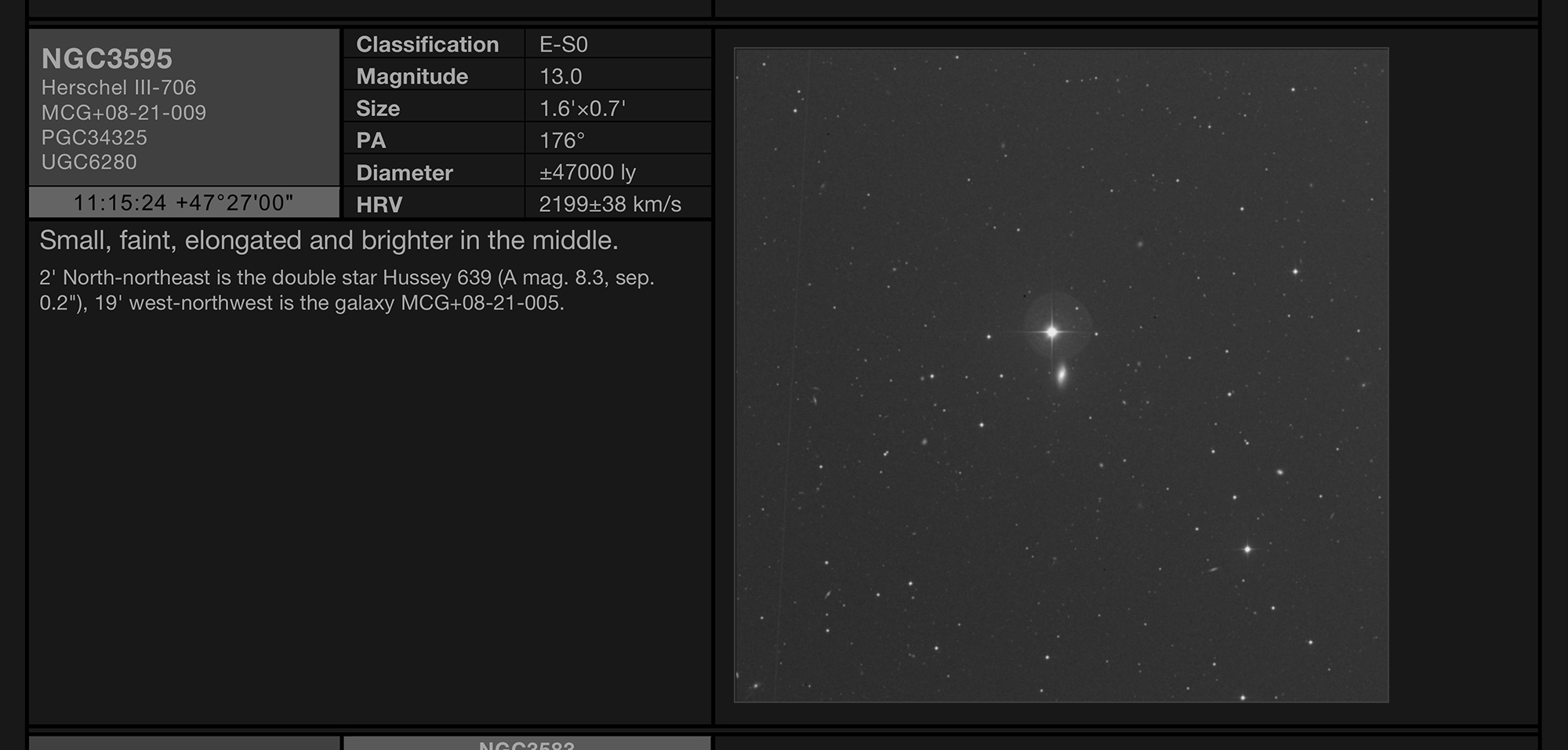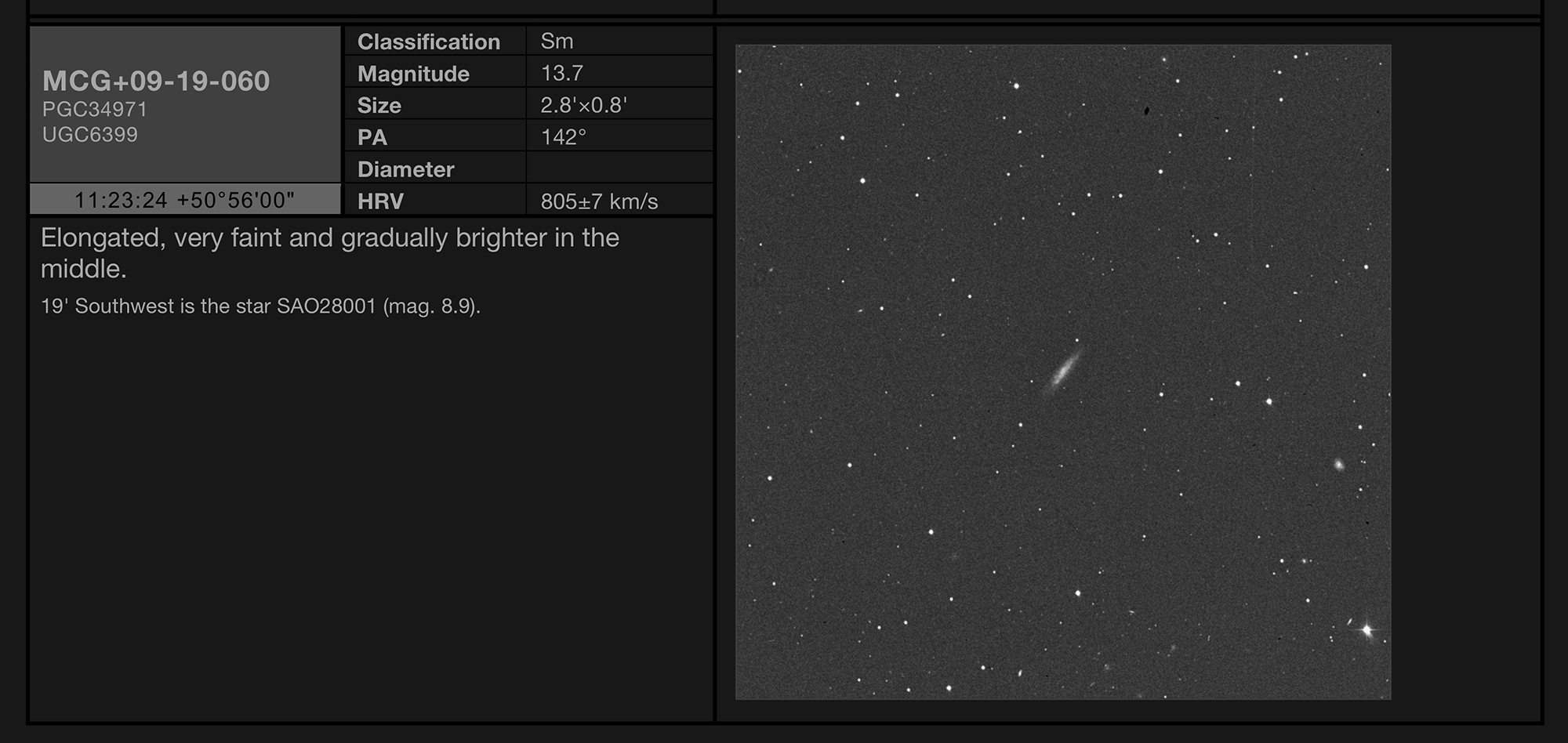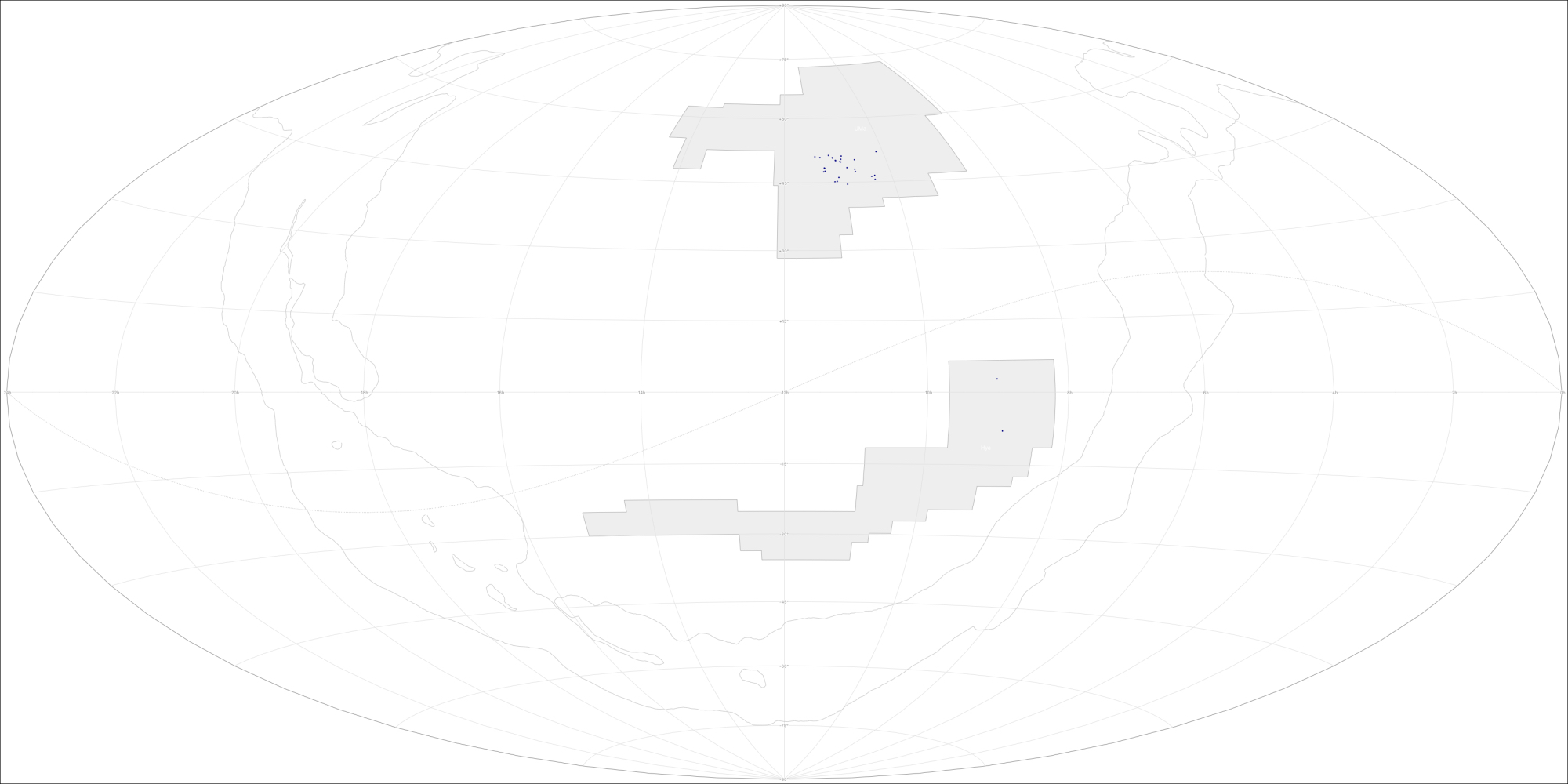Verclause, spring 2024
10 April - blog 2 of 2
Astronomers complain about the weather. That's just what we do. Clouds are our archnemesis but we like to gripe about transparency, seeing and just about every other atmospheric effect, too.
This astrotrip the weather left little to be desired during daytime, but nights were a different story. Clouds aplenty and often not even a promise of clear skies. That was unfortunate, but as it goes for every cloud, there was a silver lining: literally thousands of files for CSOG 3.0 required editing. Nothing fancy, just work required to tidy up a publication that is expected to approach (if not exceed) 50,000 pdf's. For that purpose I dragged along a screen to convert the kitchen of the gîte into a temporary office space. The result is that I managed to complete all work that I intended to complete and more... and I now wish I had a fireplace in my home office, too.



The surroundings of the gîte are typical for this region of France. Forests, rocky rural roads and no shortage of stunning views. This time of year the deciduous trees were becoming green and even the cat at the local supermarket shifted color.



The wait for clear skies lasted until the final night. That evening on 10 April the clouds promised to stay away until well after midnight. With a bit of luck, I would have been able to squeeze in about 4 hours of observing before getting at least a few hours of decent sleep with the homebound drive ahead of me. The end of evening astronomical twilight that night was when the clock stroke ten and 20 minutes prior to that I was all set to kickoff the session with some double stars in Hydra. The Moon was still up but only a very thin crescent and about to tuck away behind the hills to the west.
Did I mention astronomers always encounter something that's detrimental to their endeavors? I may have left one out: desert sand, in the atmosphere. I knew it was there as rain deposited plenty of it on my telescope's tripod plate, but not having had the opportunity to gaze at any stars during the week past, I had not yet encountered its optical effects.

First double 17 Hydra a.ka. STF1295 was nice. WDS lists spectrum A for both components but I found them clearly contrasting with A bright yellow and B white.
STF1302 is almost 10 degrees farther north, but centering the double in my eyepiece I could tell something was off. The view altered from a moment when components A and B were clearly discernible as individual stars, to a single, wooly elongated smudge and back. Other stars in the field displayed the same effect. Weird. I had little doubt that sand in that part of the atmosphere, closer to the southern horizon, was to blame. It definitely wasn't the seeing as it was not a tremble but intermittent, irregular fuzziness instead. Just another phenomenon stargazers have to deal with. I recalled a night in April 2015 when there was such an abundance of Sahara sand in the sky I decided to not uncover the scope altogether.

17 Hydrae (STF1295)
16mm Nagler T5: AB split. A nice double.
A is bright yellow, B is white, clearly contrasting.
9mm Nagler T6: Using this magnification A is yellowish. The spectra in WDS2023.12 for A and B are A2 and A7 respectively, but with use of 16mm, too, A is clearly yellow, not a deep hue but clearly contrasting.
STF1302
16mm Nagler T5: AB just split, C is visible with AV, ABC split.
A and B are both yellowish.
The stars are remarkably "wooly" at times, suspected to be due to desert sand in the atmosphere; it's clearly not due to the seeing. At these moments AB is elongated on the PA but not split and no individual stars can be discerned.
9mm Nagler T6: AB split. The view 'jumps' notably from good to bad and back. All stars in the field become 'wooly', it's not 'trembles' from the seeing.
With only these two observations I left Hydra alone and shifted my attention to the great bear in the zenith instead. Of the 37 galaxies in CSOG's 12-14" Gx-12 guide, 17 were on my wanted list for first time observations. The remaining 20 were faint fuzzies I observed only under Dutch skies and back in the year 2011.
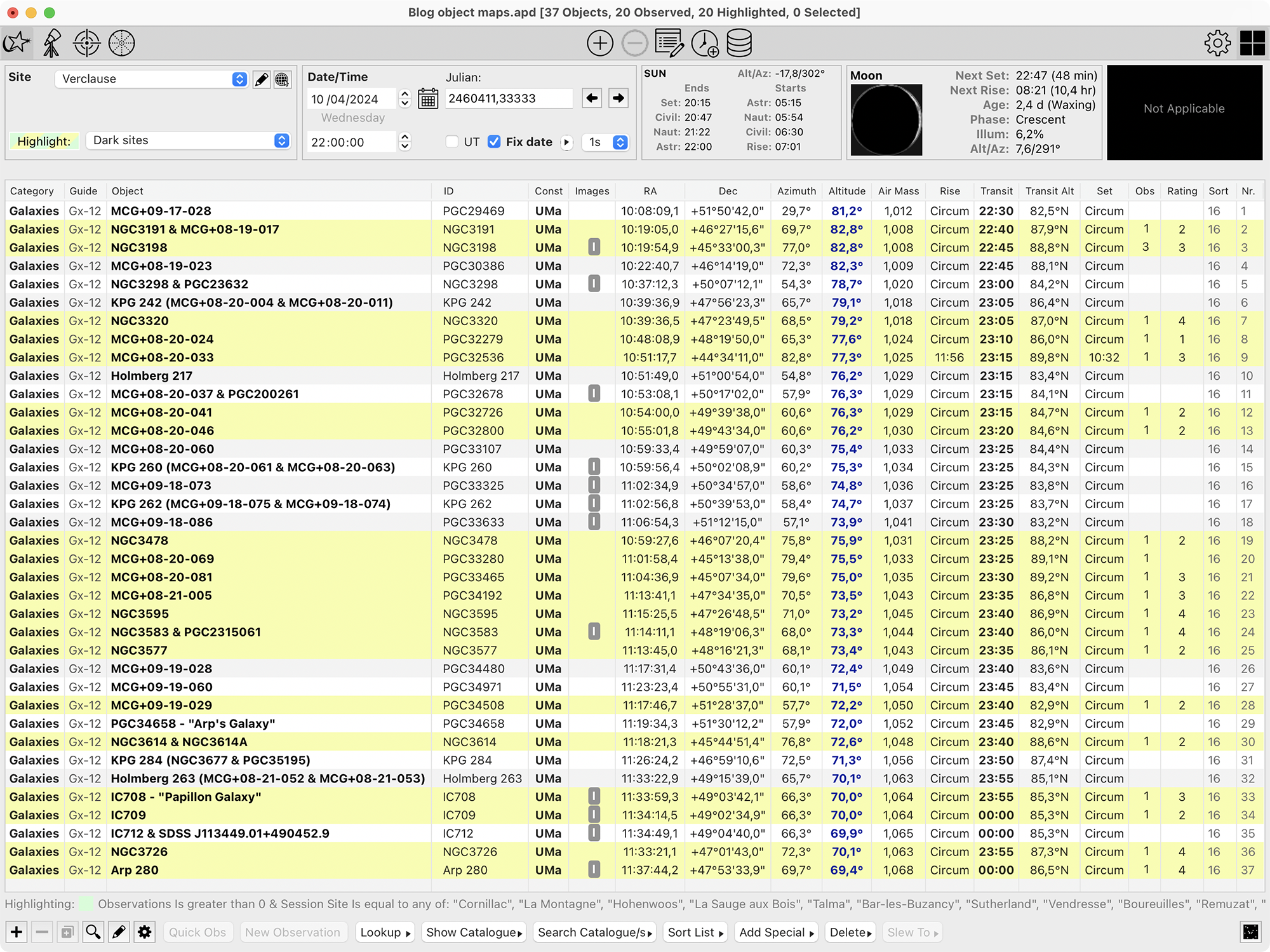

Both NGC3191 and MCG+08-19-017 (PGC30128) are small galaxies that lack detail, but seeing them together made for an above-average view. The images below - as all CSOG images in this blog - are from upcoming new or updated CSOG 3.0 editions.
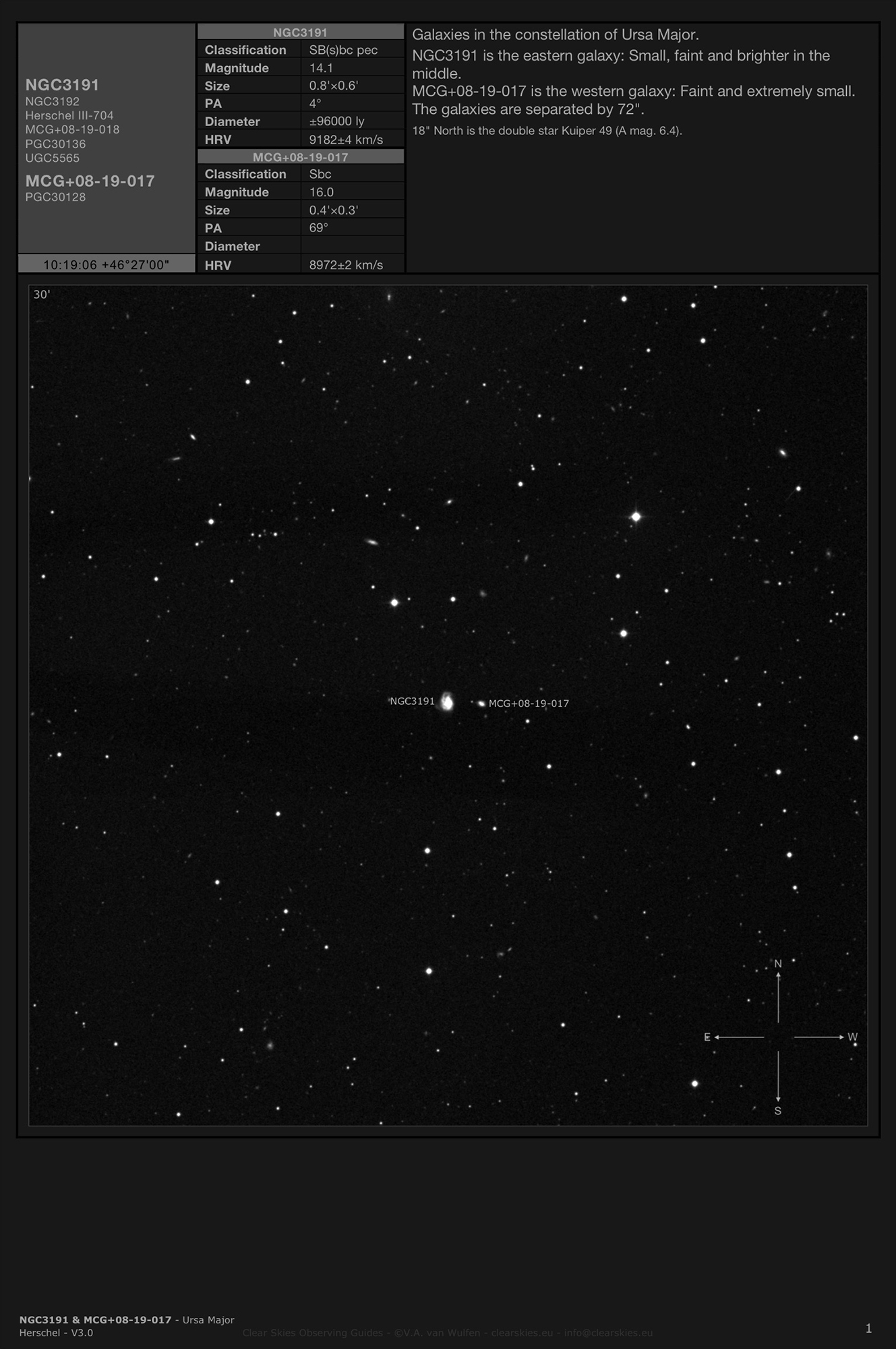
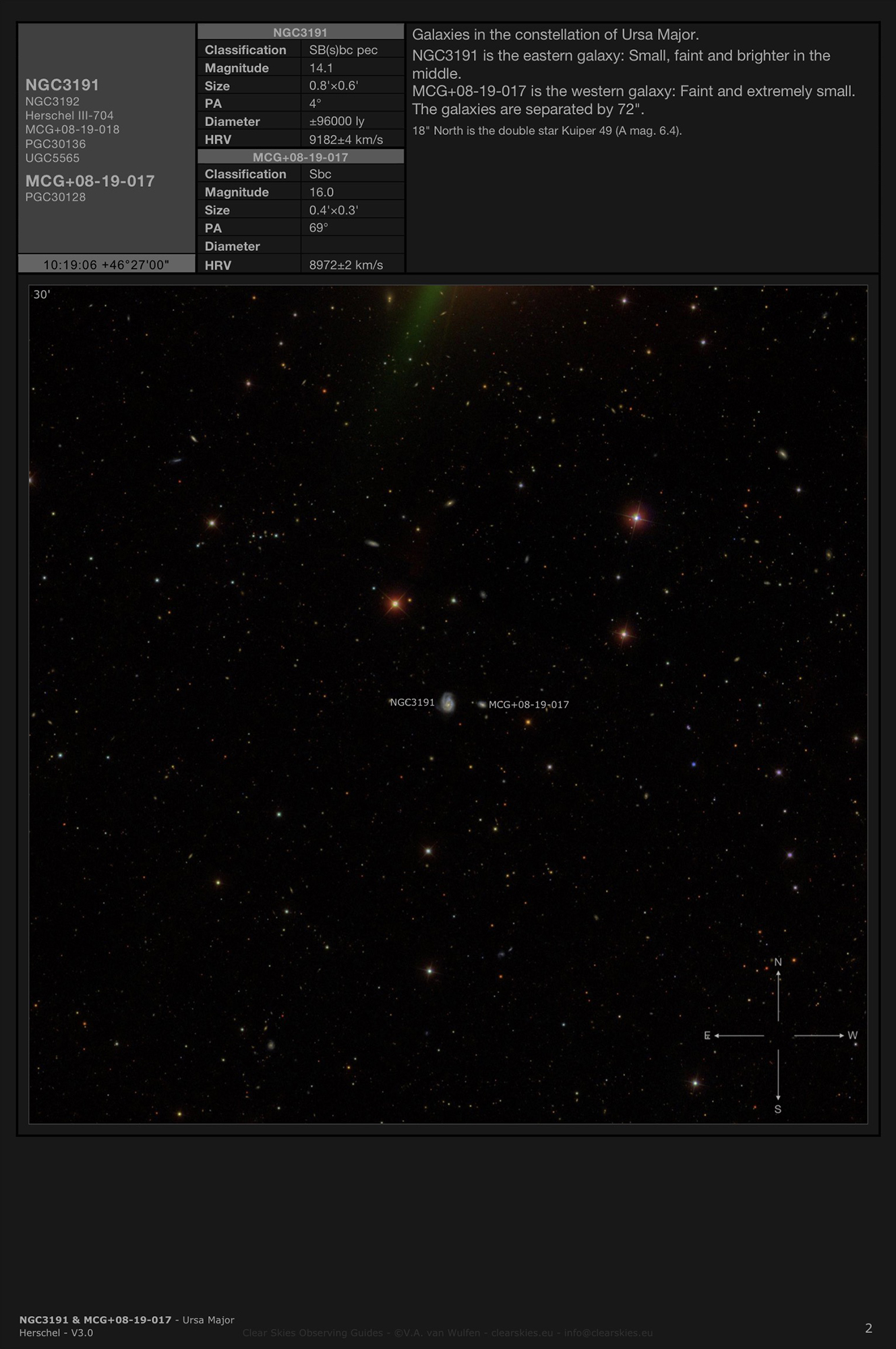
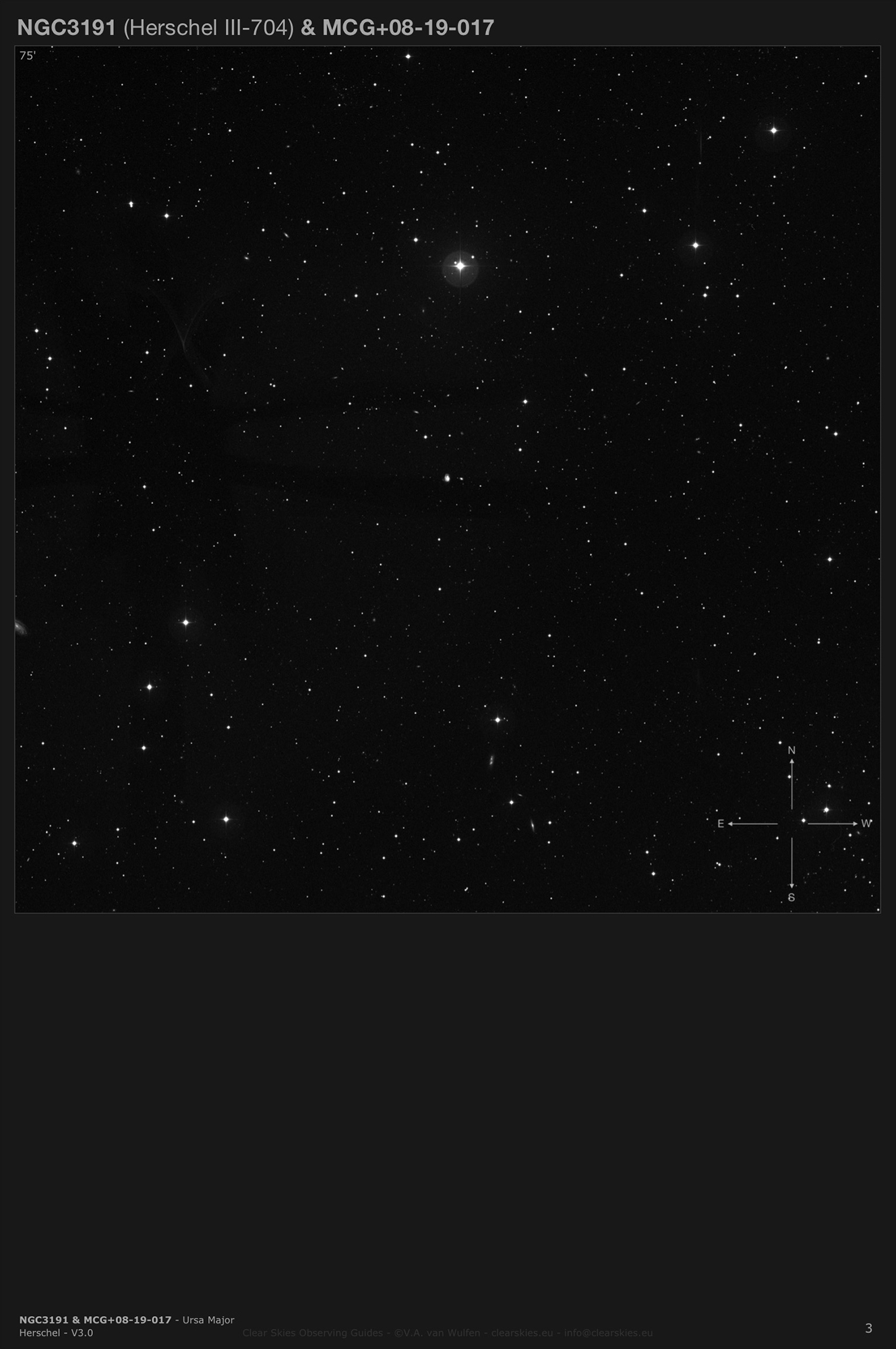
Both galaxies are visible.
The eastern galaxy NGC3191 is larger and brighter than the western galaxy MCG+08-19-017 (PGC30128) is, without AV almost round, with AV a faint, slightly north-south elongated glow, gradually brighter in the middle, no nucleus visible.
The western galaxy MCG+08-19-017 is a small, faint, round glow, no detail visible. Closer to NGC3191 than MCG+08-19-017 is, is a mag. 14.5-15 star.
The galaxy that followed, NGC3198, did reveal quite a lot of detail. No arms could be discerned but irregularity was notable.
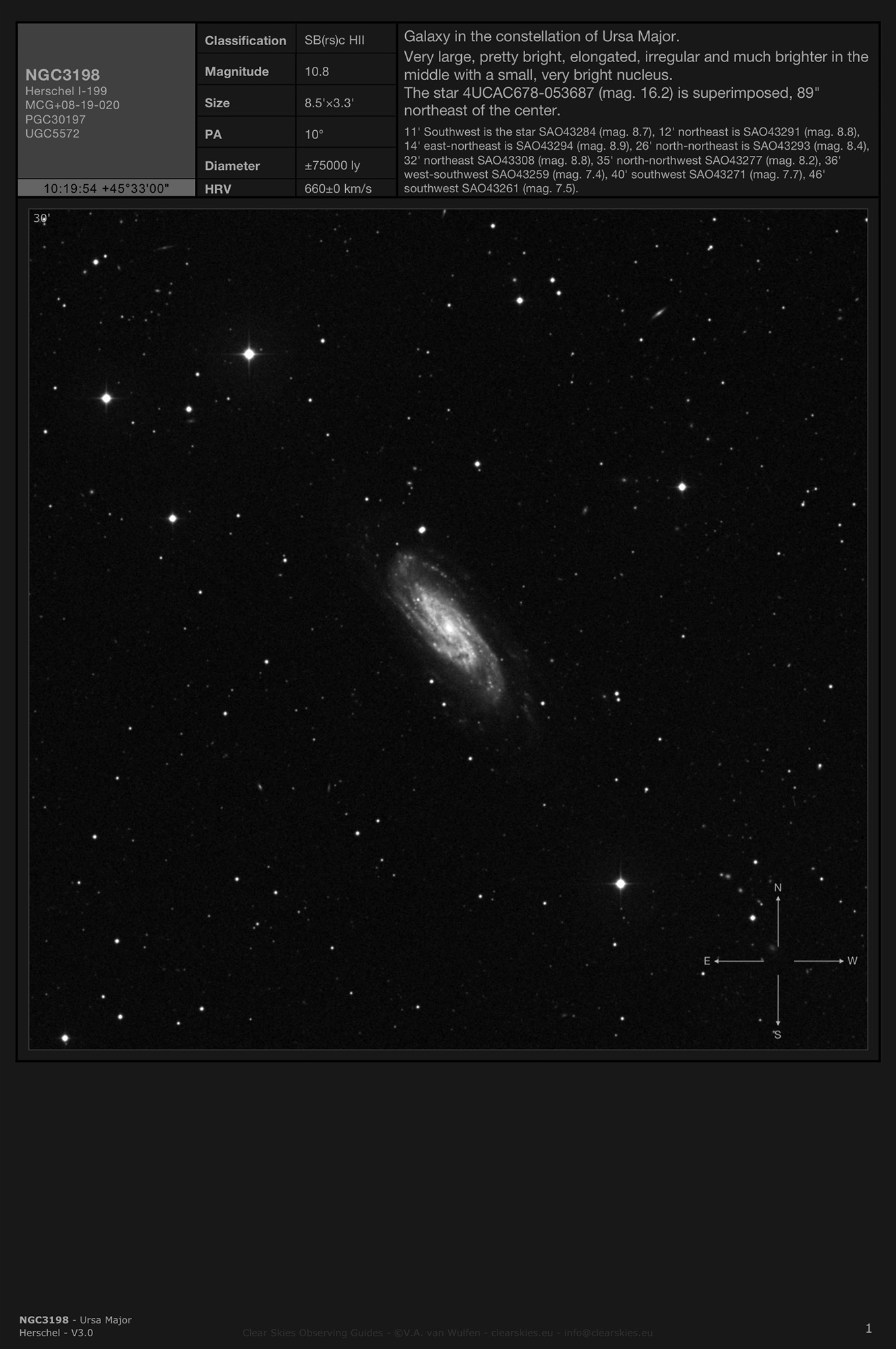
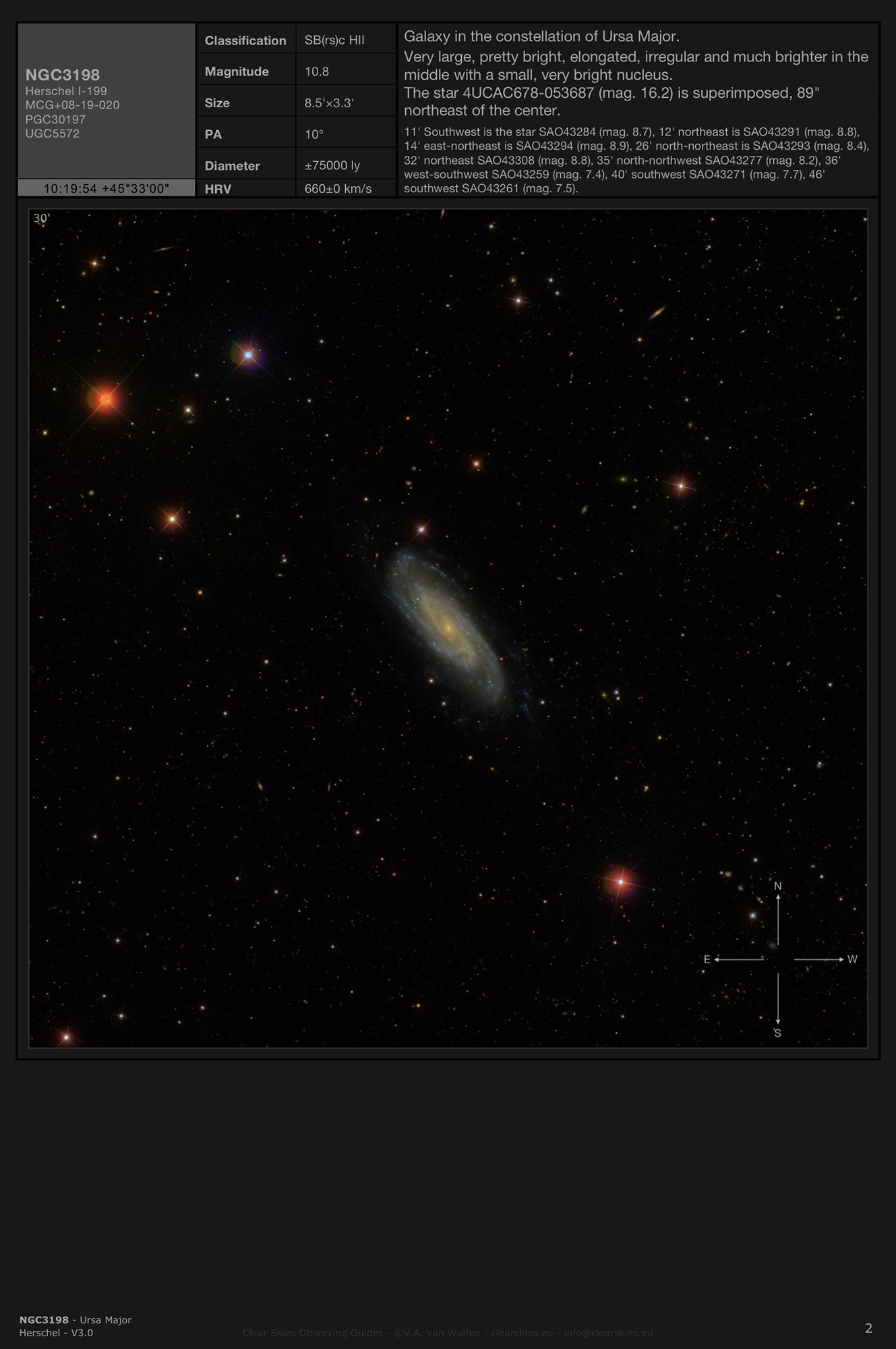
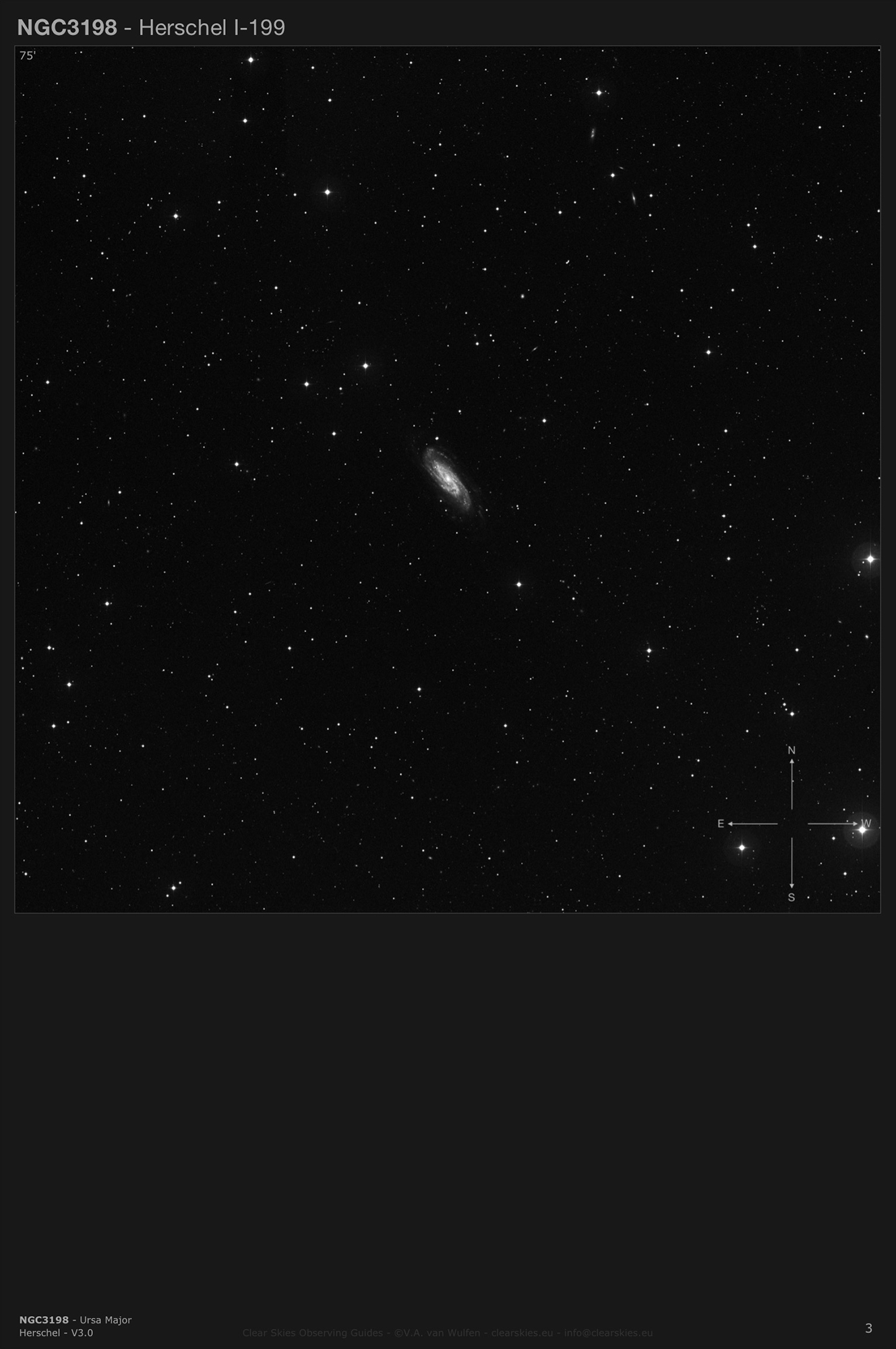
Quite a large, quite bright, NE-SW elongated glow. With AV irregular and clearly brighter in the SW-2/3 part. With AV a small, even brighter part of the galaxy is visible centrally in the galaxy, slightly elongated NE to SW containing the small, stellar nucleus of the galaxy. With AV the galaxy is most irregular to the SW of nucleus. The irregularity is notable but no arms are discernible.
The galaxy gradually faints towards the SW and more abruptly towards the NE.
The first of 3 KPG pairs observed in this session (actually 4, but the pair that forms NGC3406 is part of Holmberg 217) was KPG 242. This wide pair of elongated streaks is separated by a mag. 10.5 star.
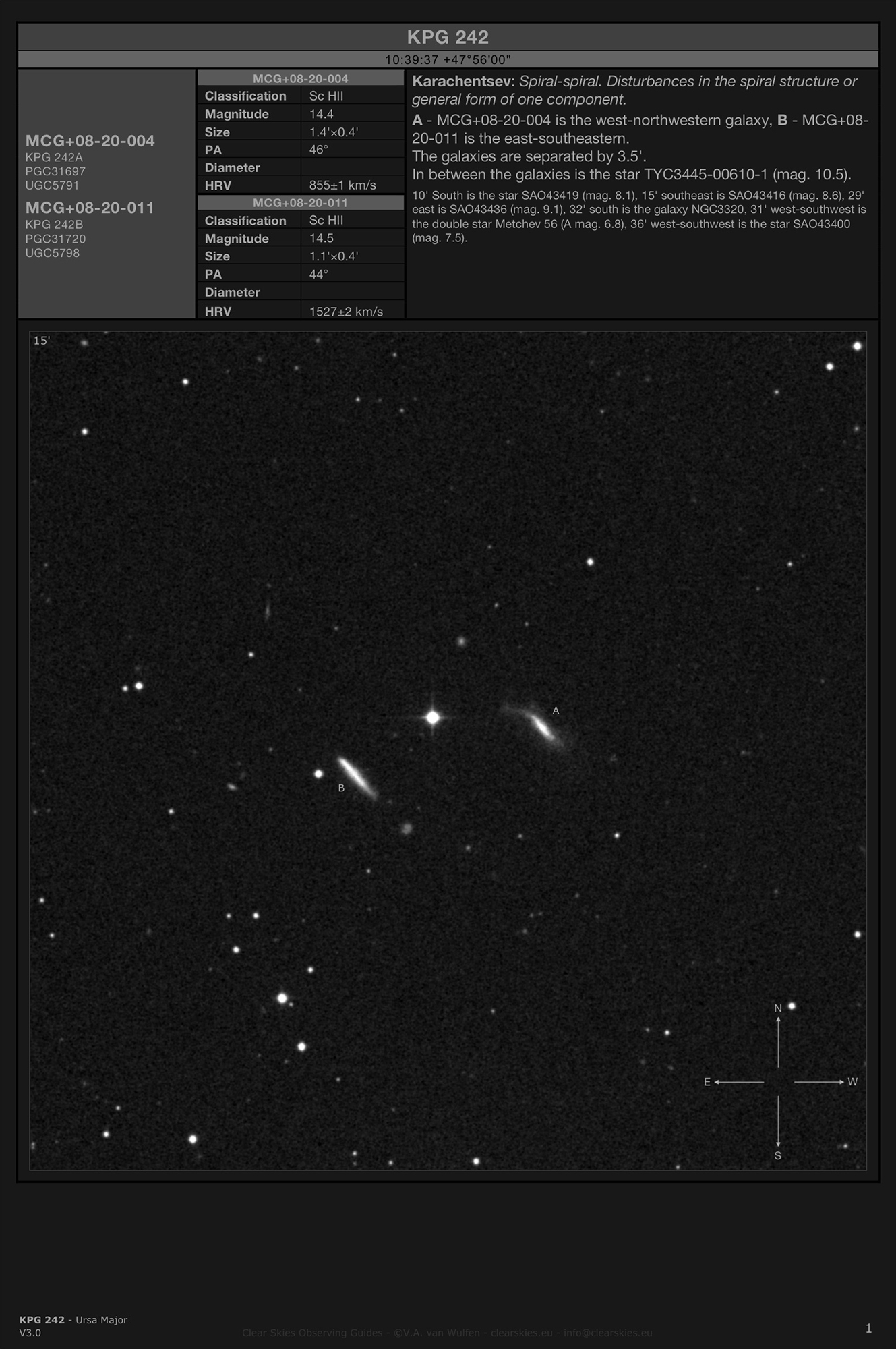
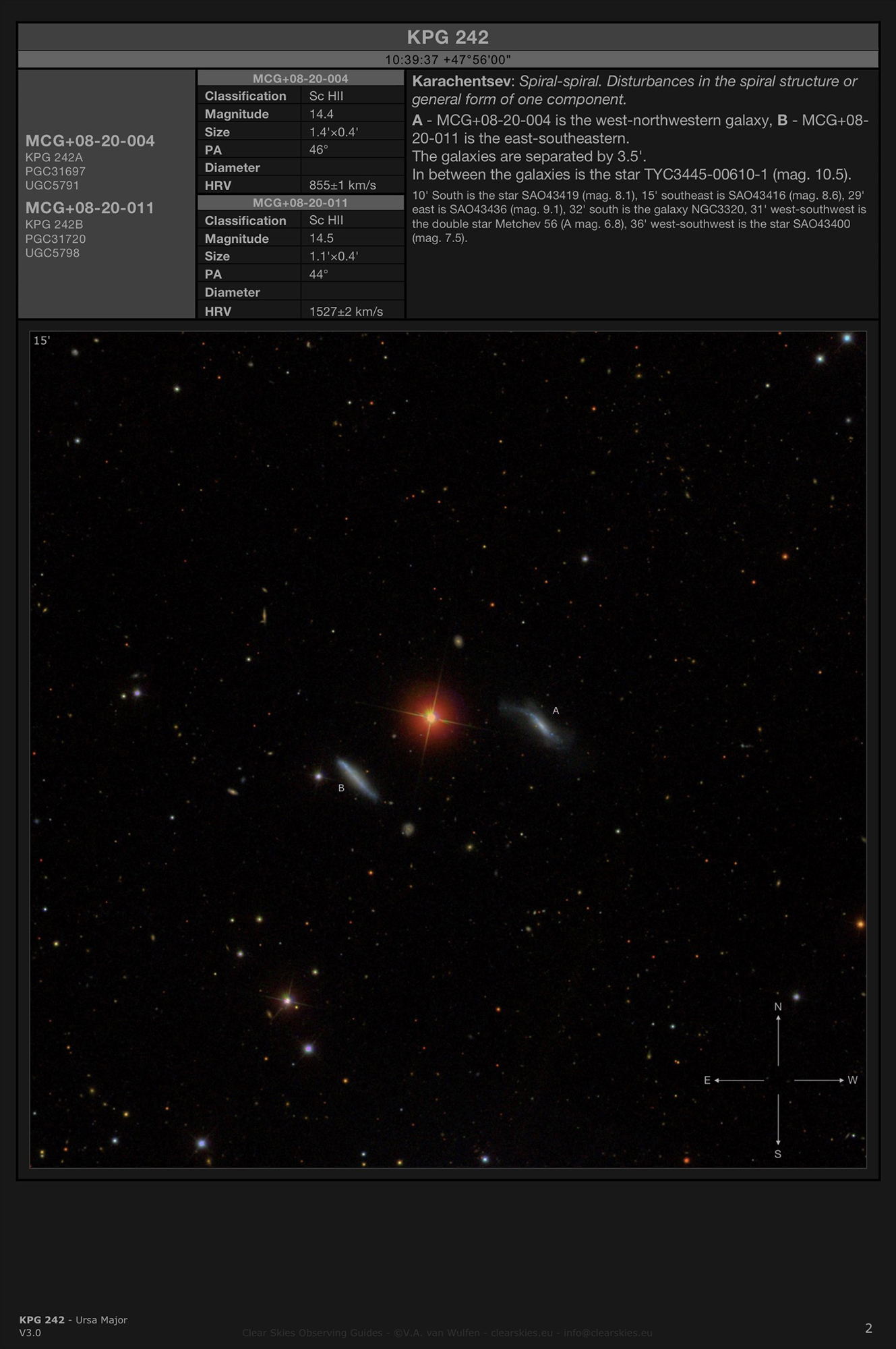

Both galaxies are visible.
The WNW galaxy A - MCG+08-20-004 (PGC31697) is clearly brighter than the ESE galaxy B - MCG+08-20-011 (PGC31720) is, a NE-SW elongated little streak, gradually brighter in the middle, no core and no nucleus visible.
The ESE galaxy B - MCG+08-20-011 (PGC31720) is elongated in the same direction as A - MCG+08-20-004 (PGC31697) is but is clearly fainter, even in brightness without AV, with AV gradually slightly brighter in the middle. To the east is a mag. 14 star.
In between the galaxies and slightly towards the north is a mag. 10.5 star.
Just over half a field of view to the south of the KPG is NGC3320. Another nice one, relatively bright and sporting a star on its southwestern edge.
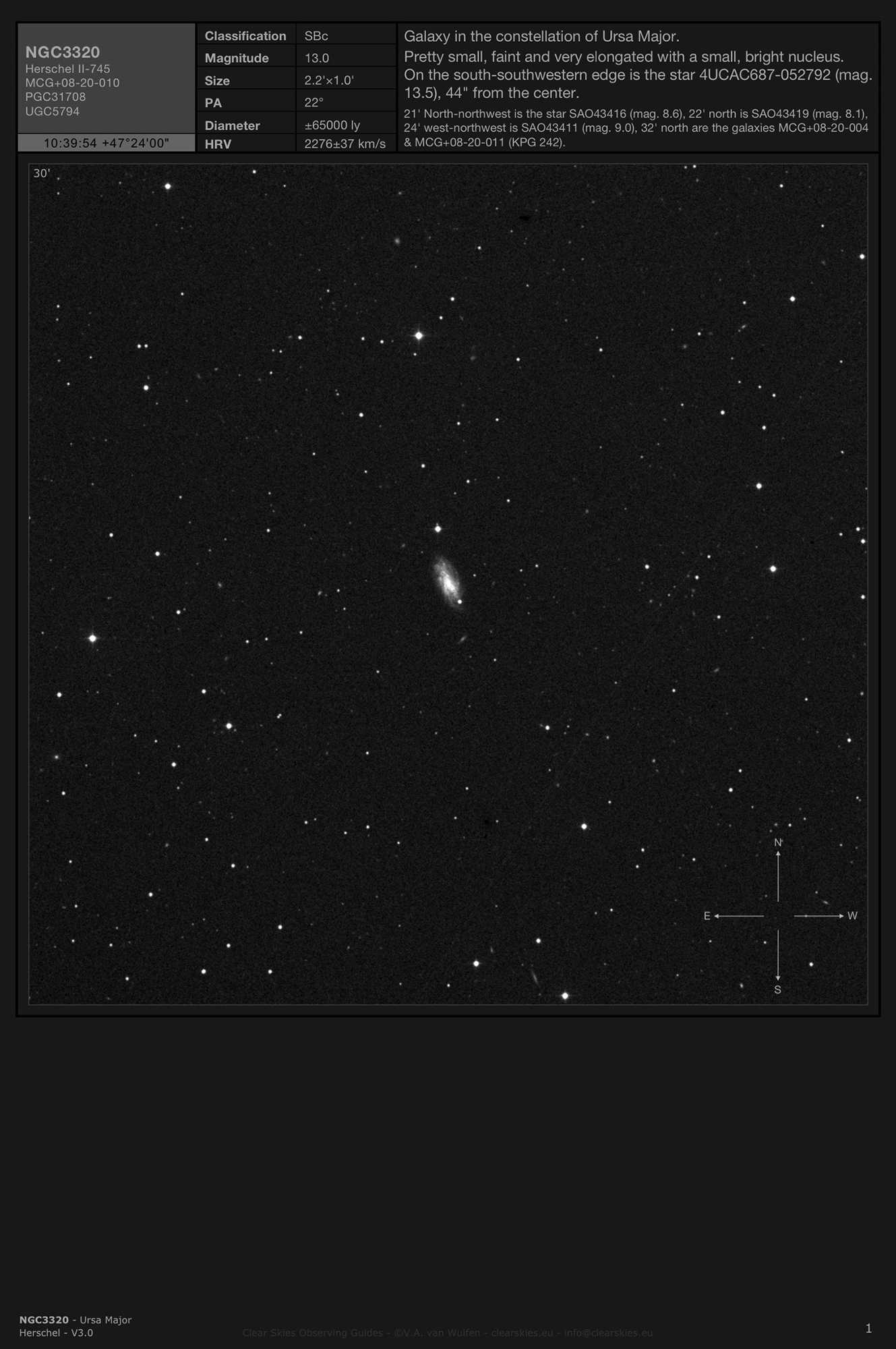
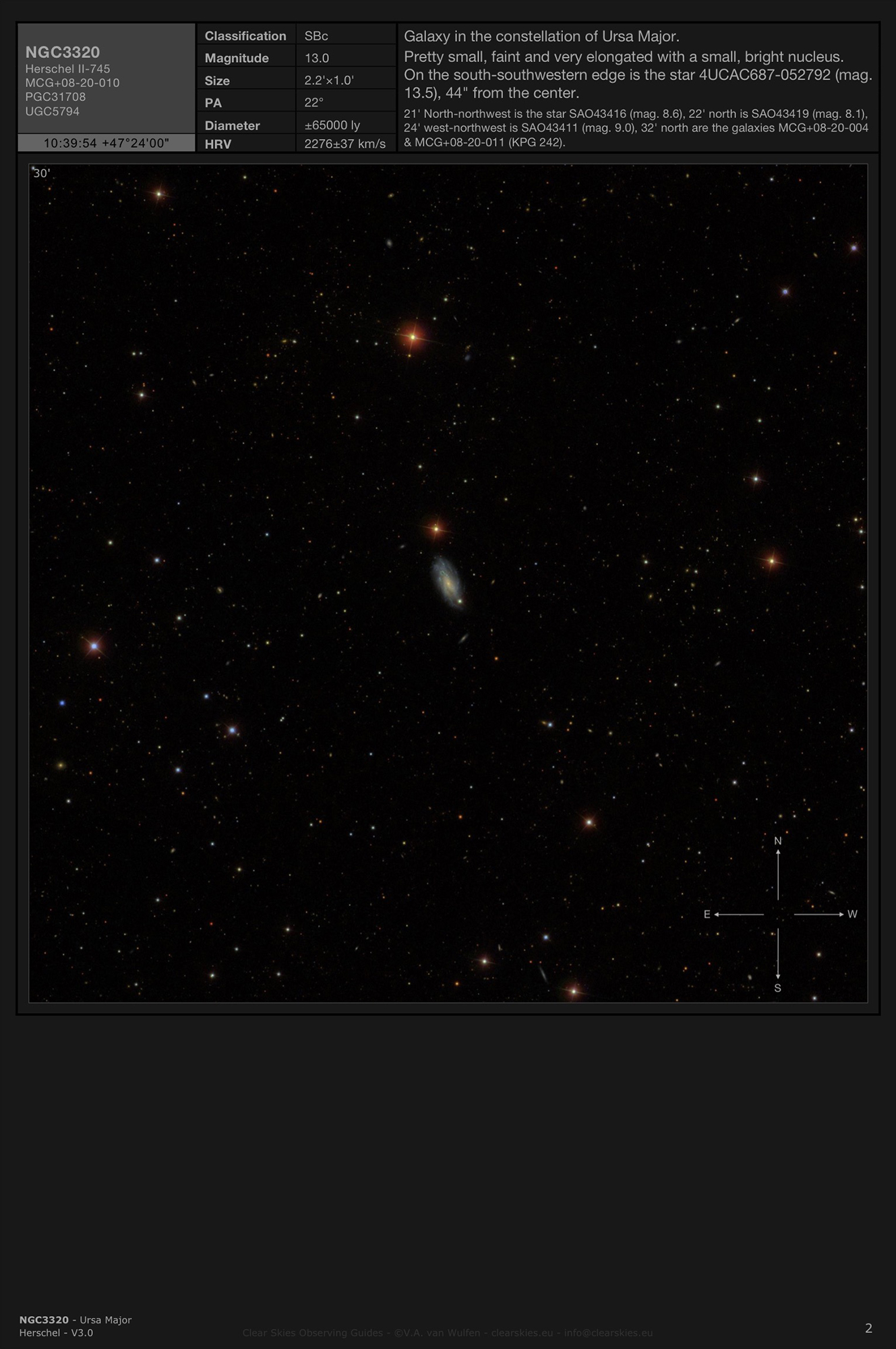
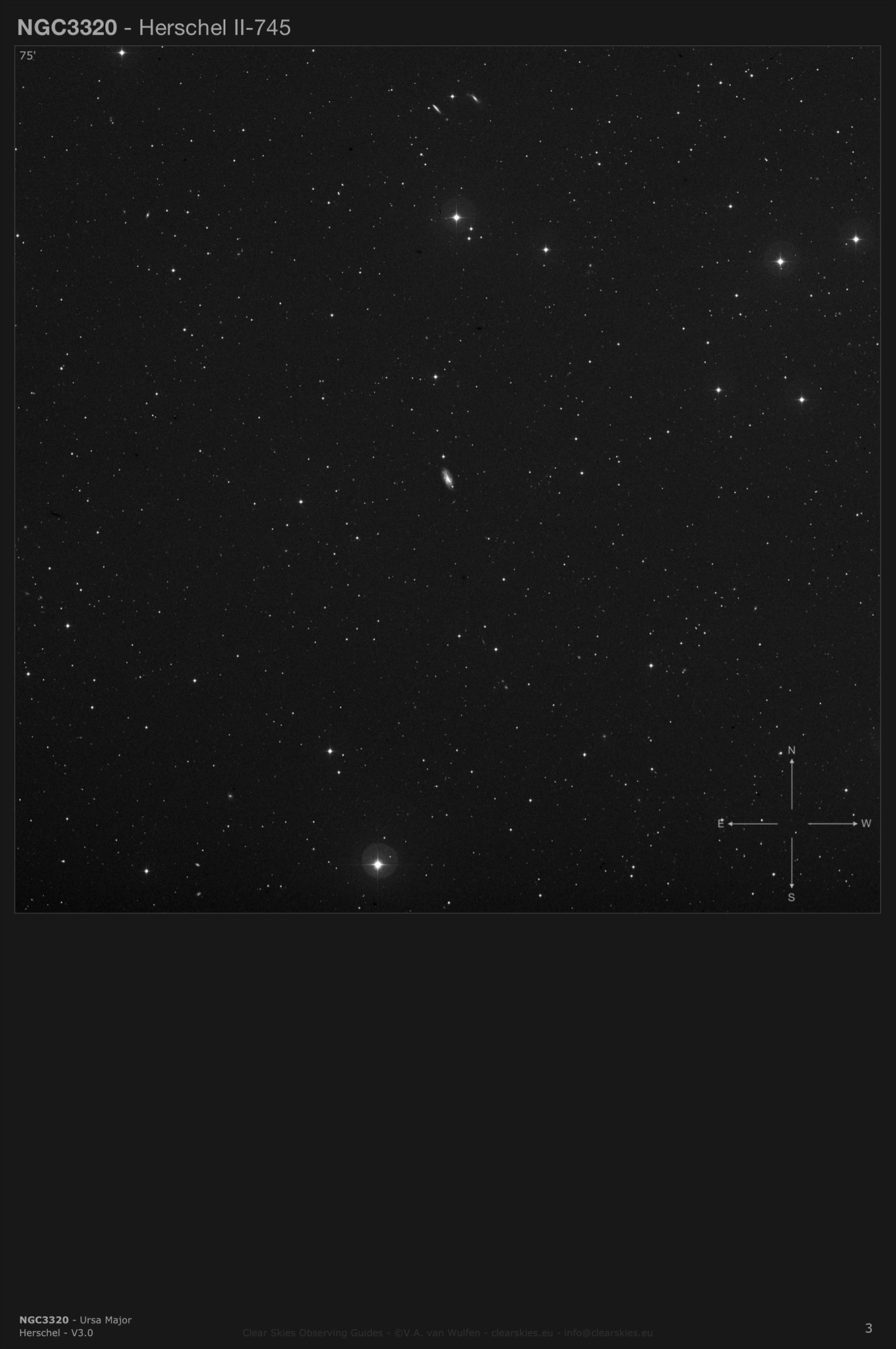
Quite a bright, NNE-SSW elongated glow with a mag. 13 star (4UCAC687-052792) on the SW edge. The galaxy is clearly brighter SSW of the middle, the SSW-2/3 of the galaxy is the brightest. With AV the transition to the brighter SSW part is slightly more sudden and the brighter part is irregular. No core and no nucleus visible.
Next up was MCG+08-20-033 (PGC32536) and that smudge contained a surprise. It's a small one but its core is very bright and the transition from the outer regions to that brighter core is very sudden.

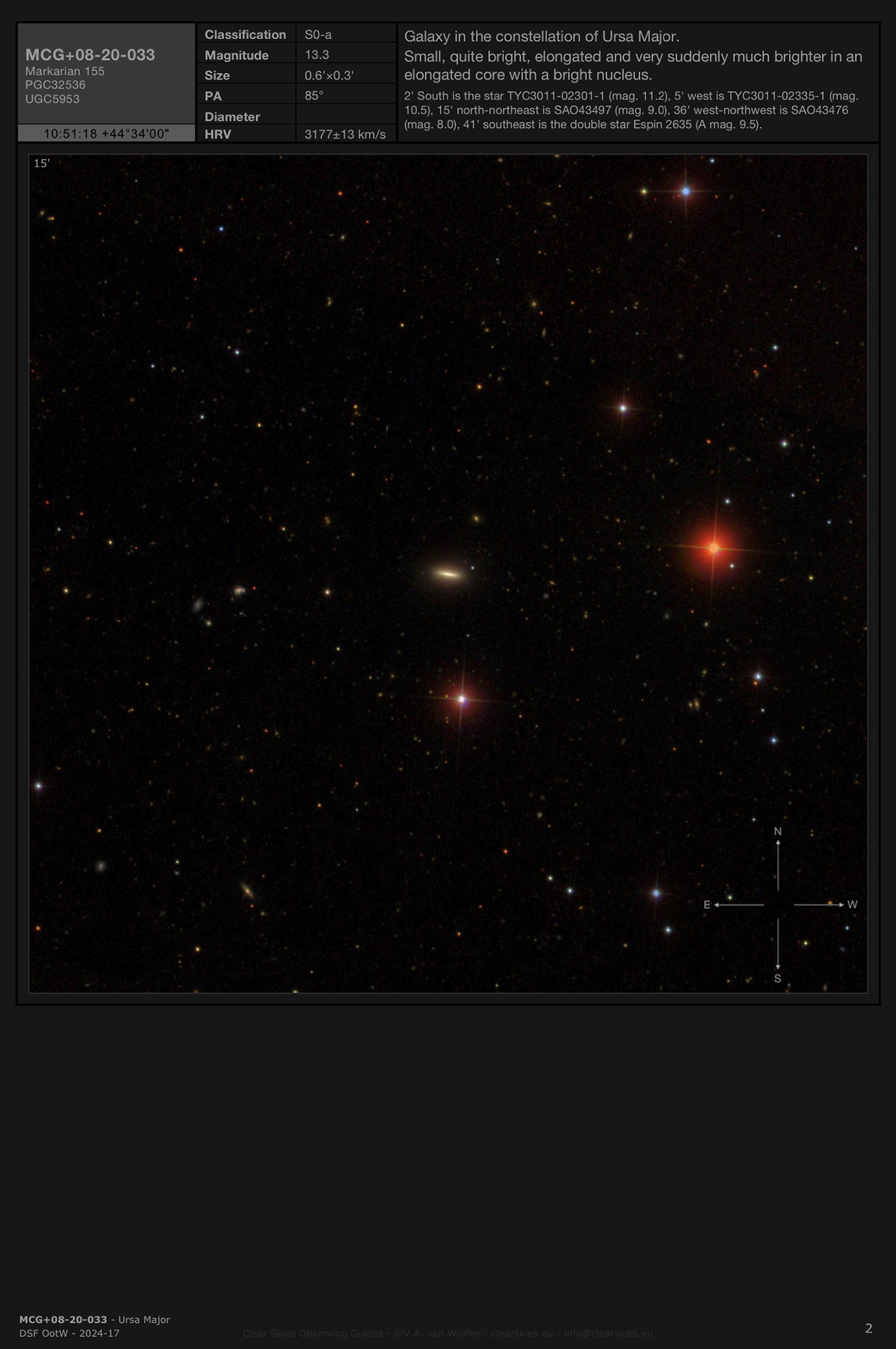
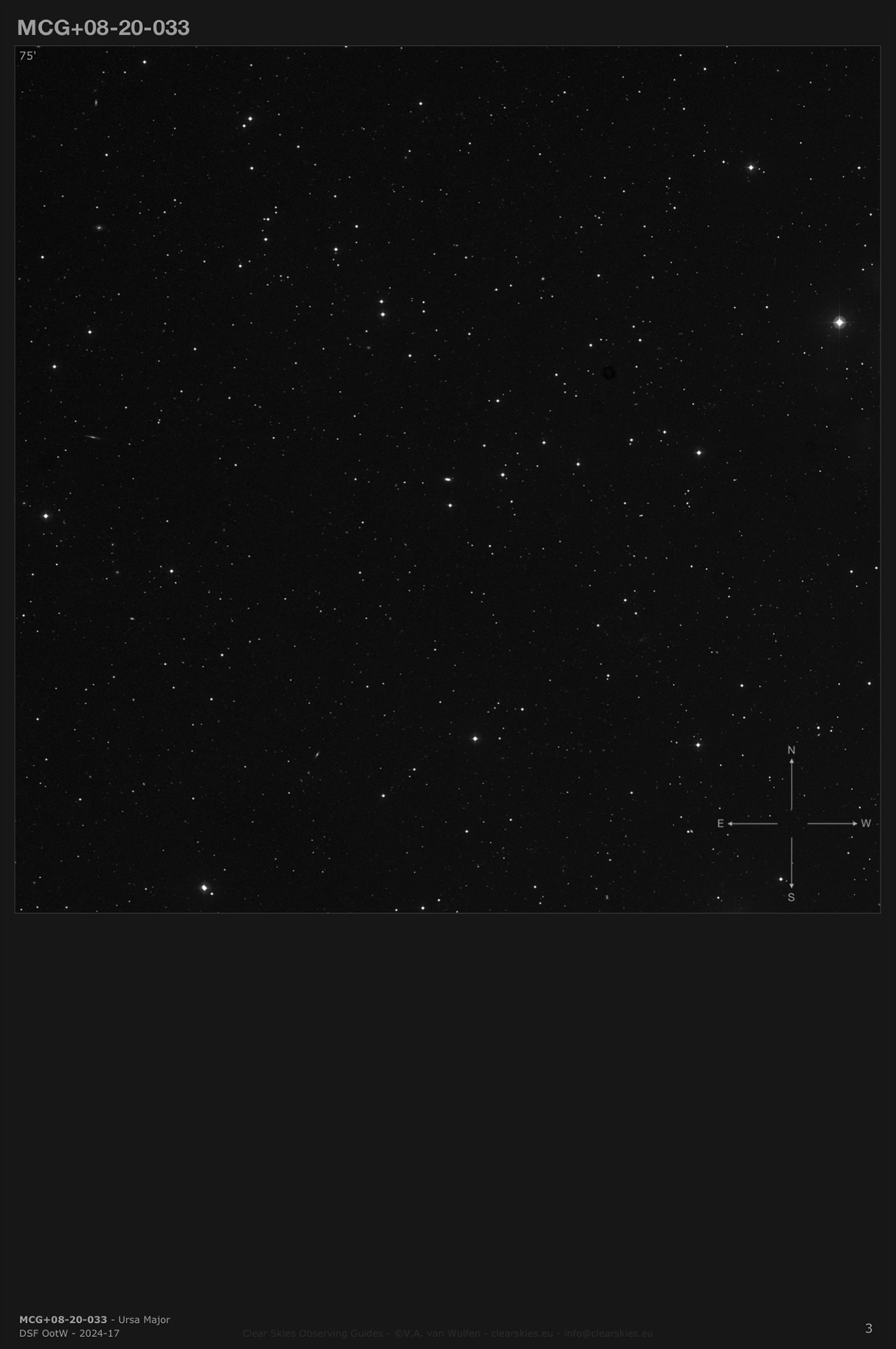
Without AV a slightly east-west elongated glow, gradually brighter in the middle with a bright nucleus that is clearly visible without AV. With AV the galaxy is more elongated and suddenly brighter in a bright, notable core that is elongated in the same direction. The sudden transition to the core is notable. The nucleus is just a bit west of the middle.
The galaxy is in the right angle of right angled triangle with a mag. 11 star to the south in the shorter leg of the triangle and another mag. 11 star 2 1/2 times that distance towards the west in the longer leg of the triangle.
I figured it would make for a nice Object of the Week on Deep Sky Forum, hence the images for the OotW guide for week 17 above.
Aforementioned Holmberg 217 revealed its galaxies. Two galaxies form NGC3406 and while I did not see them separately, I could determine there were indeed 2 of them. Much fainter NGC3410 to the east-southeast was visible too, but very faintly and only with use of averted vision. Nearby PGC2386525 did not reveal itself.


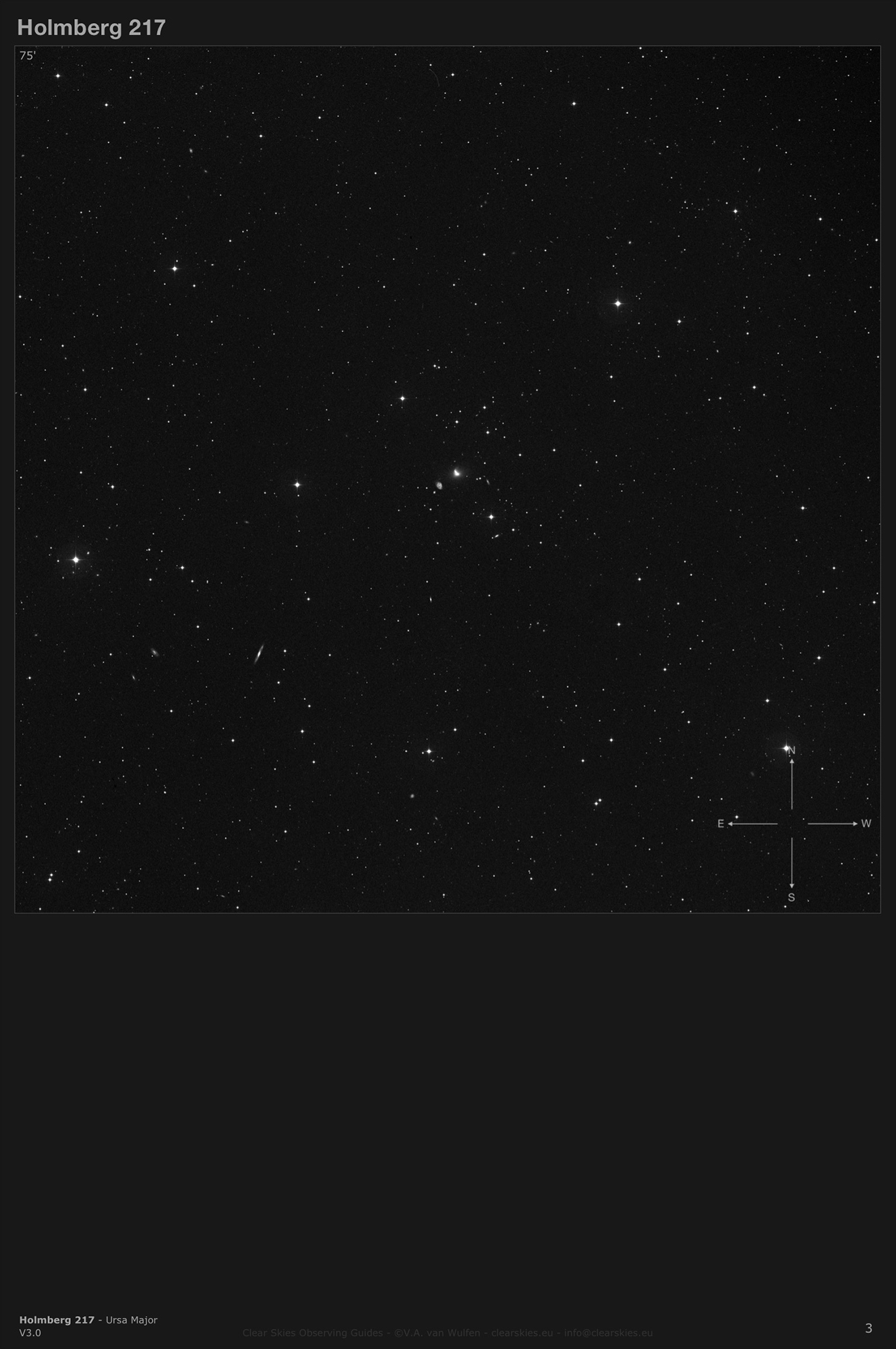
The galaxies that form Holmberg 217 are visible.
The two galaxies PGC32580 (KPG 253A, SW) and PGC93106 (KPG 253B, NE) that form NGC3406 (Holmberg 217A) are visible, without AV an irregular glow, with AV even more irregular and brightest in the SSW part where the glow is wider east to west and in which a nucleus is visible. The NNE part of the glow is clearly fainter and is elongated NNE to SSW: with that it's clear that there are two galaxies.
To the ESE of the galaxies that form NGC3406, NGC3410 (Holmberg 217B) is visible, a faint, round glow, only visible with AV, no detail visible. To the ESE of NGC3410 is a mag. 15 star, farther to the SSE is a mag. 13 star.
PGC2386525 to the SE of NGC3410 is not visible.
Two more KPG's made it into my eyepiece this session: KPG 260...

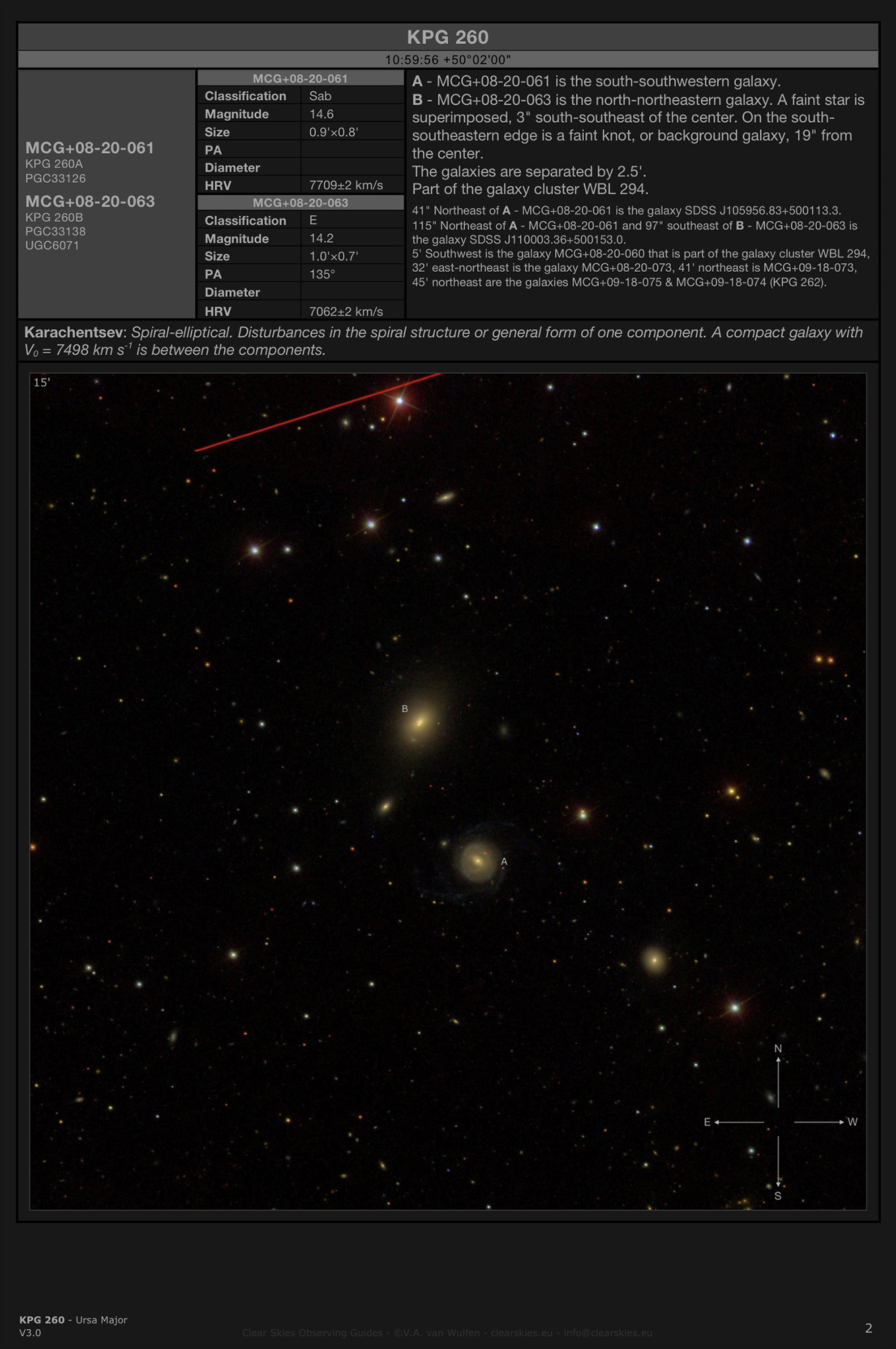
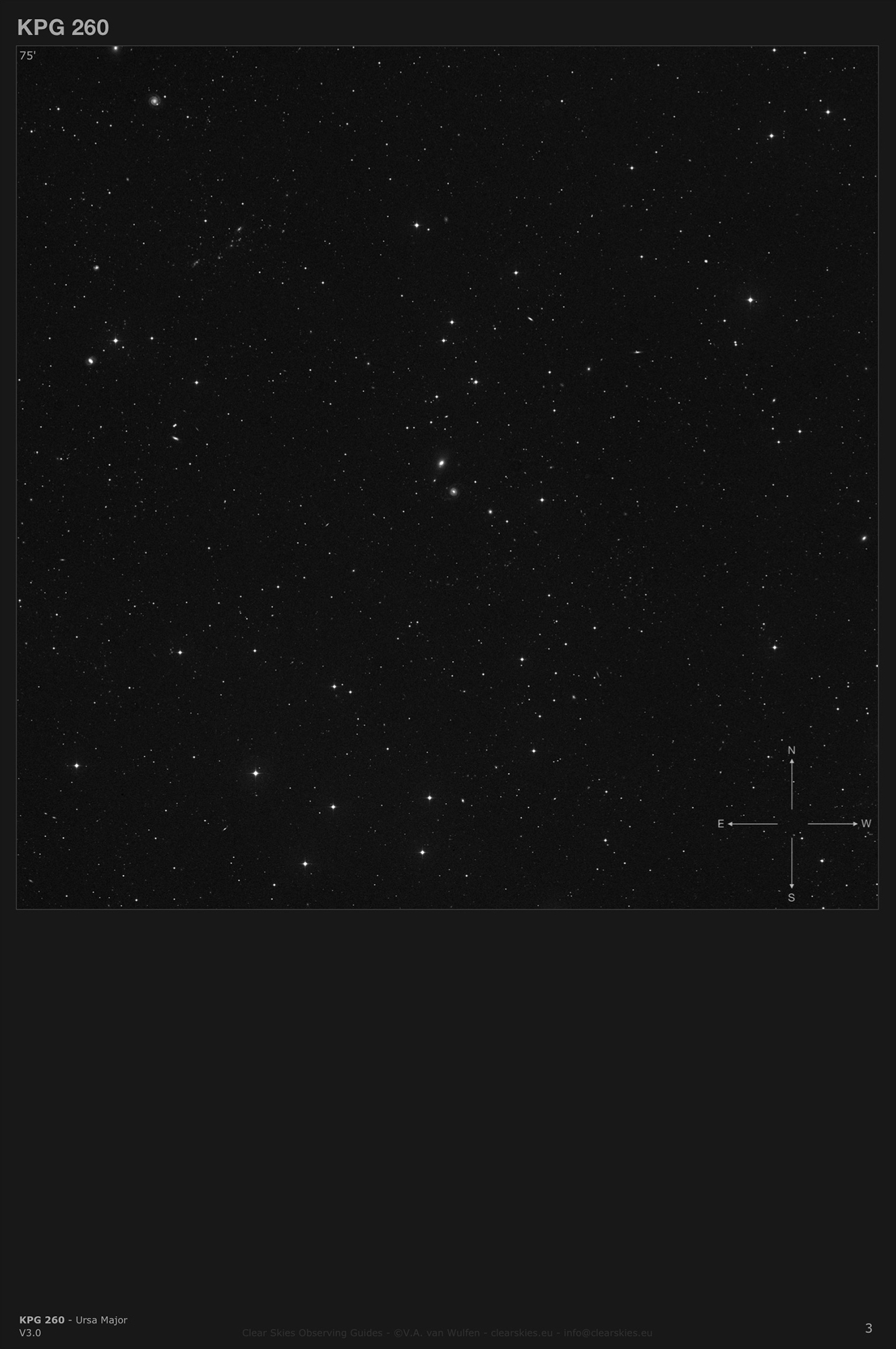
Both galaxies are visible.
The NNE galaxy B - MCG+08-20-063 (PGC33138) is brighter than the SSW galaxy A - MCG+08-20-061 (PGC33126) is, a rond glow, quite suddenly brighter in a small, round core with quite a bright nucleus that is just visible without AV.
The SSW galaxy A - MCG+08-20-061 (PGC33126) is fainter than the NNE galaxy B - MCG+08-20-063 (PGC33138) is, without AV even in brightness and slightly elongated east to west, with AV slightly more elongated and gradually brighter in the middle, no nucleus visible.
To the SW is the fainter galaxy MCG+08-20-060 (PGC33107).
... and KPG 262, that also goes by Vorontsov-Vel'yaminov 1408.

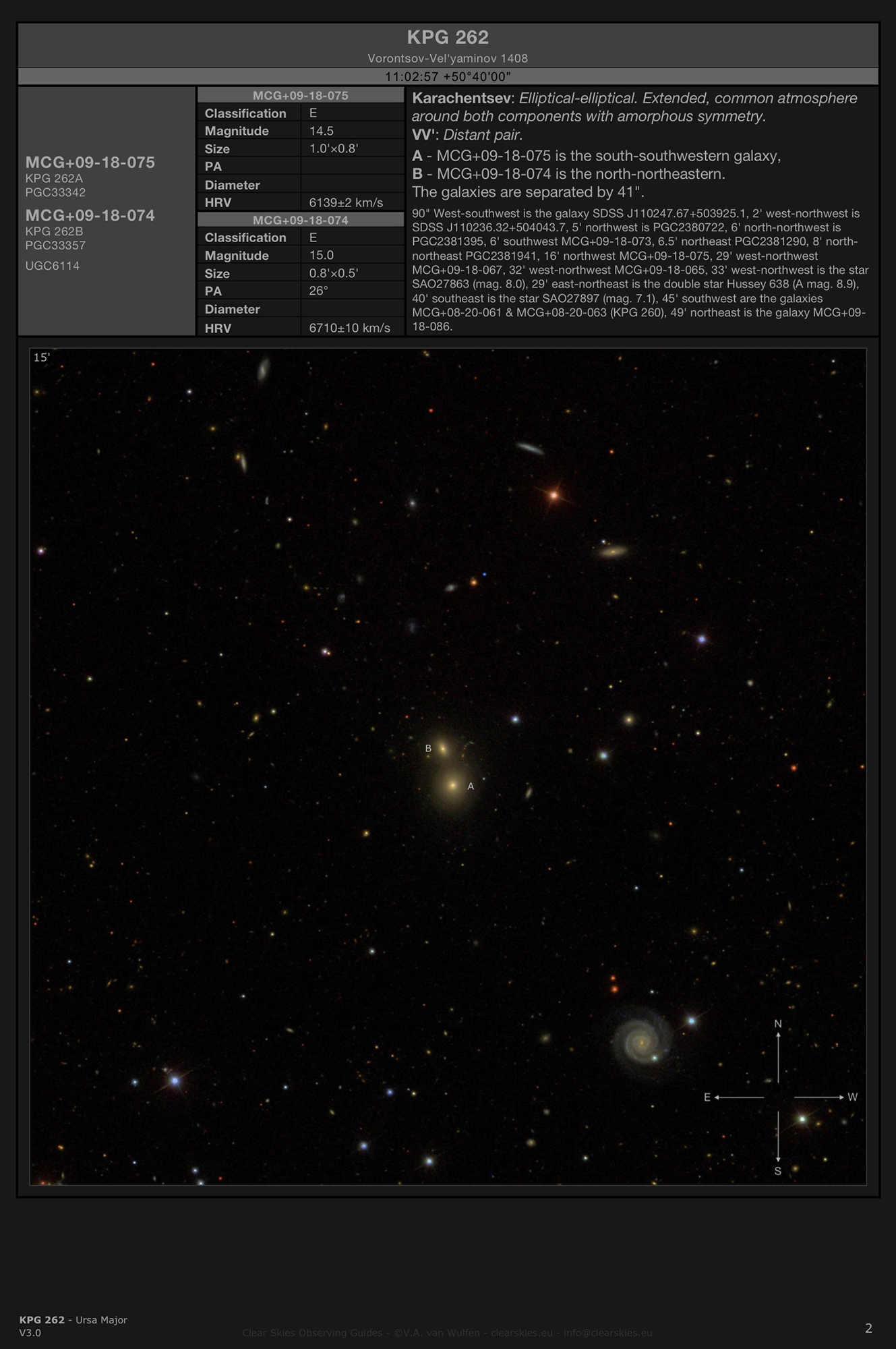

Both galaxies are visible.
The SSW galaxy A - MCG+09-18-075 (PGC33342) is slightly brighter than the NNE galaxy B - MCG+09-18-074 (PGC33357) is, a round glow, without AV the nucleus is at the limit of visibility, with AV the galaxy is gradually brighter in the middle.
The NNE galaxy B - MCG+09-18-074 (PGC33357) is fainter than the SSW galaxy A - MCG+09-18-075 (PGC33342) is, slightly elongated NNE to SSW and even in brightness, no detail visible, no core and no nucleus visible.
A nice pair of galaxies to compare round (A) with elongated (B).
1/4 FoV to the SSW is the galaxy MCG+09-18-073 (PGC33325).
Observing NGC3595, I noticed the mag. 8.5 star to its north-northeast to play a little optical trick. It was at times creating spikes towards the north and south. Desert sand in this part of the atmosphere, too, or..?
A north-south elongated streak, gradually brighter in the middle, the nucleus is visible without AV. With AV the galaxy is more elongated and more of the fainter outer regions of the galaxies is visible.
To the NNE is a bright white mag. 8.5 star (SAO43659).
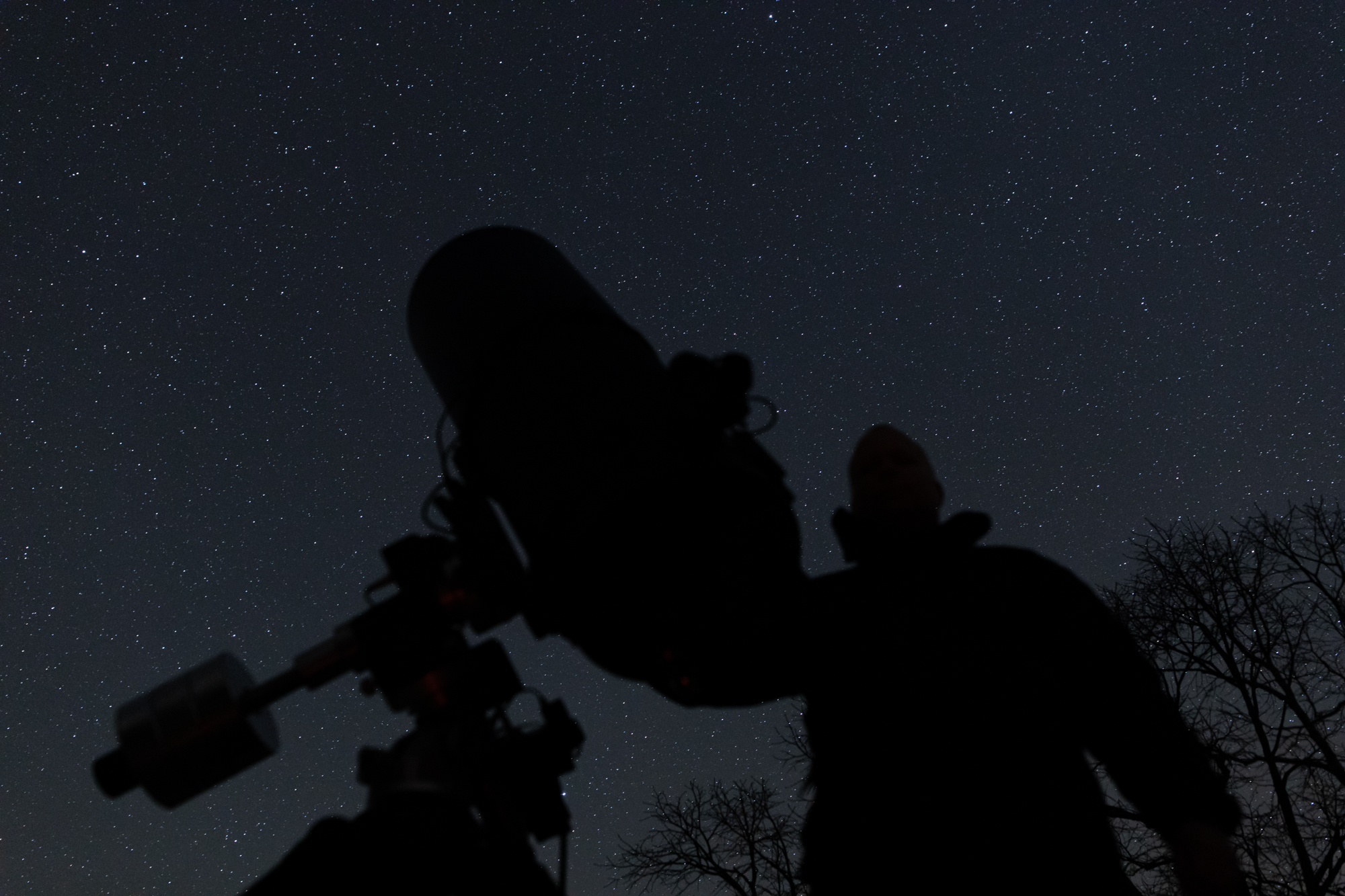
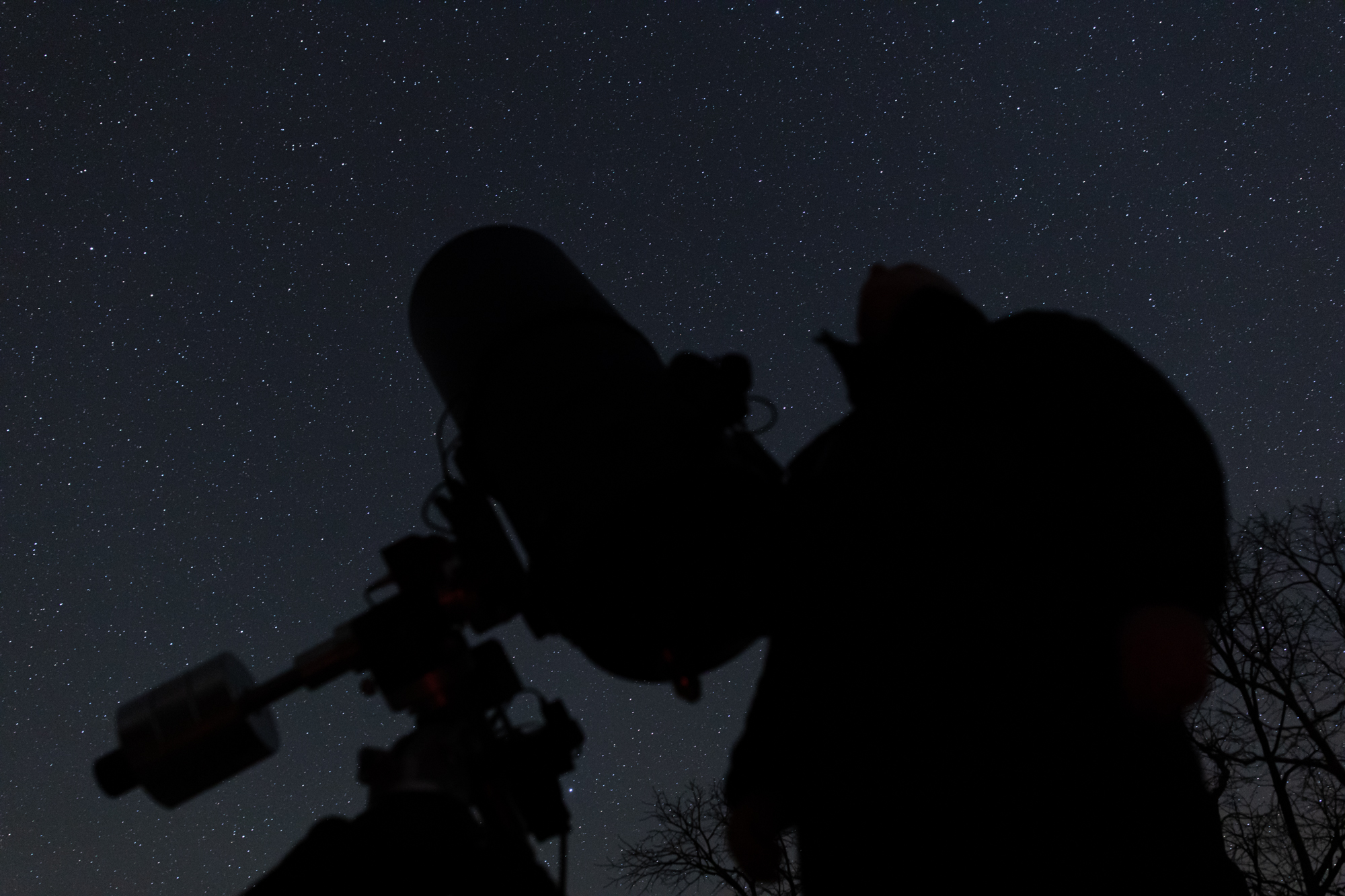
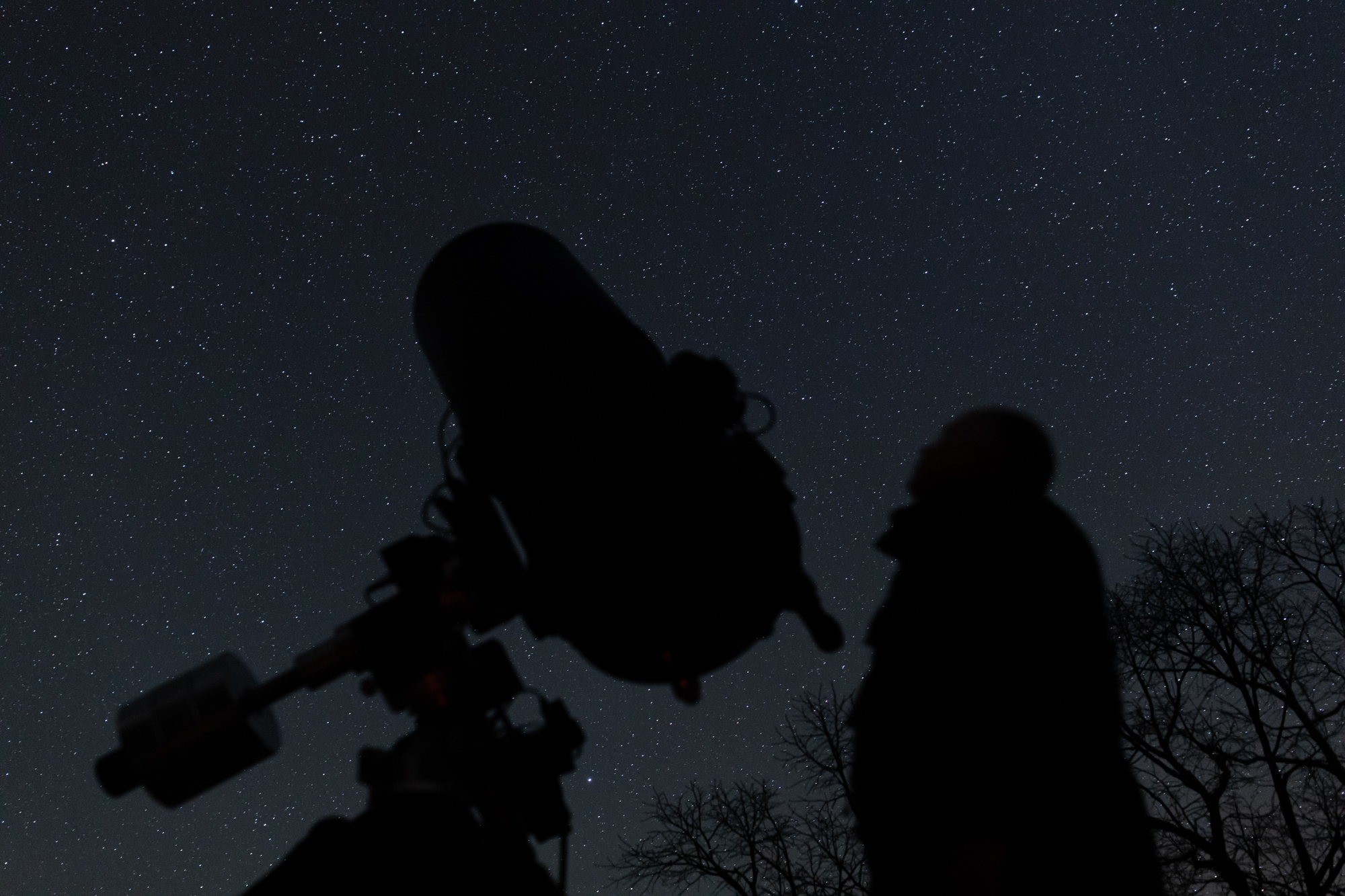
The galaxy that revealed the most detail of all the galaxies observed in this session and with that the highlight of the session, was NGC3583. Its core is offset and that core clearly showed irregular structure. Arms could not be discerned, but there was a hint. A very pleasing observation.
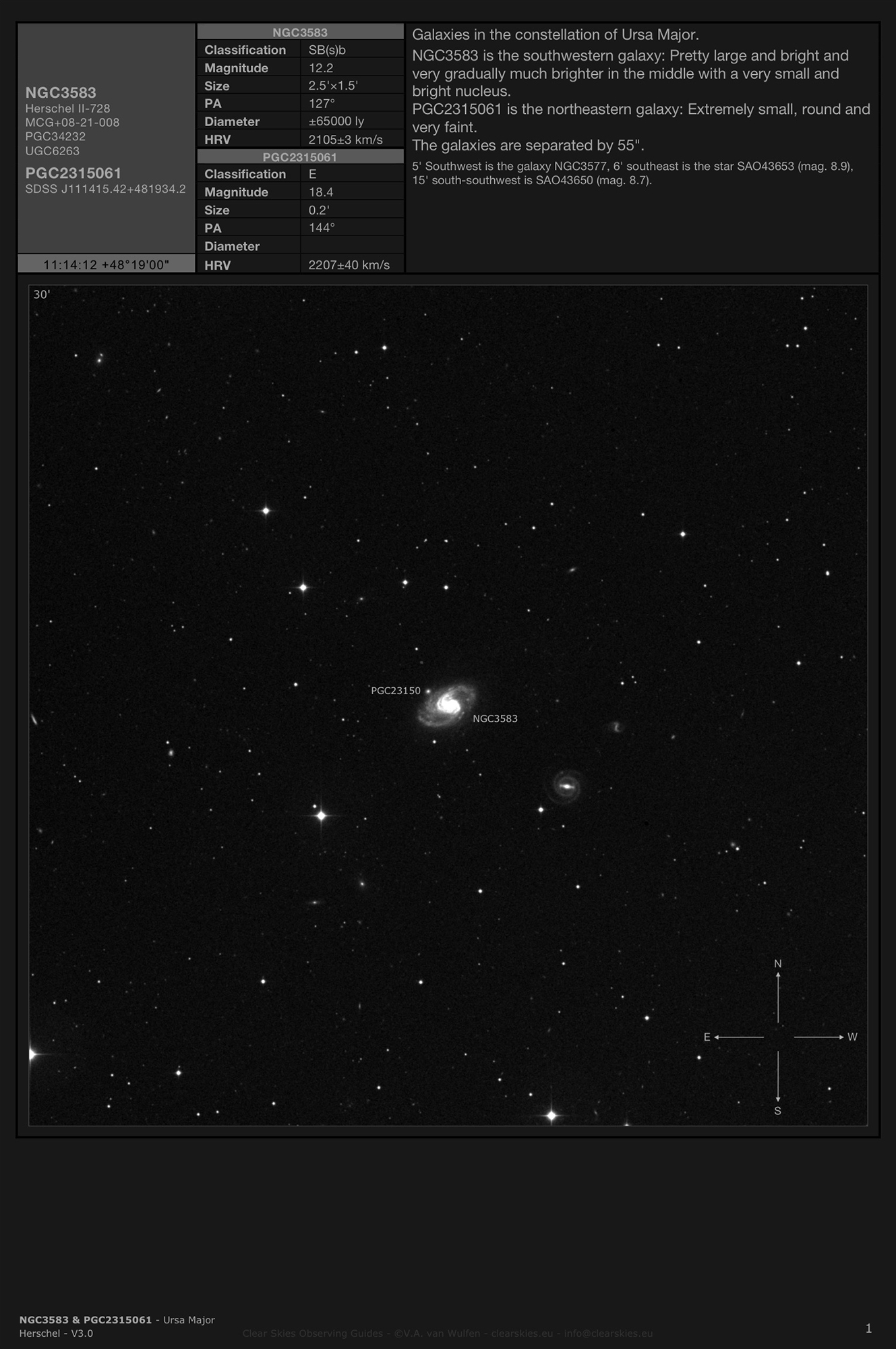


Quite a large, irregular glow, suddenly brighter in an ENE-WSW elongated core that is clearly irregular with AV and that is brightest WSW of the middle. In that brightest WSW part clearly irregular structure is discernible with AV. With AV the glow of outer parts of the galaxies in faintly visible on the SE side, on the north side, a faint, smaller part is visible using AV that curves towards the west, but that's not clearly discernible as an arm of the galaxy. A nice galaxy.
PGC2315061 to the NE is not visible.
To the SSE is a mag. 14 star, five times that distance to the SW is a mag. 12 star with the galaxy NGC3577 NW thereof.
MCG+09-19-060 (PGC34971) surprisingly did not make it into the NGC or IC list. It isn't too faint and its elongated shape is quite nice.
A faint, clearly NW-SE very elongated streak, even in brightness without AV, with AV gradually subtly brighter in the middle. No core and no nucleus visible. The elongated shape is notable.
It was then when the God's of the heavens touched the dimmer. The galaxy literally faded in front of my eyes. I leaned back from the eyepiece to see only the brighter stars of Ursa Major clearly visible, and little Alcor struggling to remain seen. The clouds were back, with vengeance and much earlier than expected.
It was the end of the session and with that the end of this astrotrip. The next morning I packed the car and set out for the return journey. 1000 clicks to drive, but nothing compared to the mouse clicks of the week past, editing CSOG content. Time well spent in splendid surroundings. V3.0 is well on its way.

Observations
28 galaxies
2 double stars
Total: 30 observations
First time observations: 16 objects
Details of the objects observed in this session are in the table below.
click here for my observing log
| Object | Designation | Object type | Constellation | R.A. / Dec. - J2000.0 | Telescope - eyepiece | Mag. / FoV | Observation notes | Double stars | Galaxy groups | Rating | Date & time - local | Lim. mag. - SQM - seeing | ||||||
|---|---|---|---|---|---|---|---|---|---|---|---|---|---|---|---|---|---|---|
| MCG+09-19-060 | PGC34971 | Galaxy | Ursa Major | 11:23:23 +50°55'31" | 14" LX850 SCT - LX850 - 17mm Nagler T4 | 168× / 29' | A faint, clearly NW-SE very elongated streak, even in brightness without AV, with AV gradually subtly brighter in the middle. No core and no nucleus visible. The elongated shape is notable. Dutch - Nederlands Een zwakke, duidelijk erg NW-ZO uitgerekte veeg, zonder AV gelijkmatig fel, met AV geleidelijk subtiel feller in het midden. Geen core zichtbaar en geen kern zichtbaar. De uitgerekte vorm is opvallend. | n/a | n/a | 4/10 | Verclause | 10 April 2024, 23:06 | 6.0 - 21.45 - 7/10 | session 10 april 2024 | 16826 | filter_ | filter_UrsaMajor | filter_10April2024,23:06 |
| MCG+09-19-028 | PGC34480 | Galaxy | Ursa Major | 11:17:31 +50°43'36" | 14" LX850 SCT - LX850 - 17mm Nagler T4 | 168× / 29' | A very faint, slightly east-west elongated little streak, only visible with AV, even in brightness, no detail visible. Dutch - Nederlands Een erg zwak, iets oost-west uitgerekt veegje, alleen zichtbaar met AV, gelijkmatig fel, geen detail zichtbaar. | n/a | n/a | 1/10 | Verclause | 10 April 2024, 23:05 | 6.0 - 21.45 - 7/10 | session 10 april 2024 | 16825 | filter_ | filter_UrsaMajor | filter_10April2024,23:05 |
| NGC3577 | NGC3577 | Galaxy | Ursa Major | 11:13:45 +48°16'21" | 14" LX850 SCT - LX850 - 17mm Nagler T4 | 168× / 29' | An east-west elongated streak, brighter in the middle, with AV more elongated. Is is clear that I can only see the brighter core of the galaxy and not fainter outer parts. To the SW is a mag. 12 star, farther to the NE is the galaxy NGC3583. Dutch - Nederlands Een oost-west uitgerekte veeg, feller in het midden, met AV meer uitgerekt. Het is duidelijk dat ik alleen het fellere centrale deel van het stelsel zie en niet de zwakkere buitenste delen. Ten ZW staat een mag. 12 ster, verder ten NO staat het sterrenstelsel NGC3583. | n/a | n/a | 3/10 | Verclause | 10 April 2024, 22:59 | 6.0 - 21.45 - 7/10 | session 10 april 2024 | 16824 | filter_ | filter_UrsaMajor | filter_10April2024,22:59 |
| NGC3583 & PGC2315061 | NGC3583 | Galaxy group | Ursa Major | 11:14:11 +48°19'06" | 14" LX850 SCT - LX850 - 17mm Nagler T4 | 168× / 29' | Quite a large, irregular glow, suddenly brighter in an ENE-WSW elongated core that is clearly irregular with AV and that is brightest WSW of the middle. In that brightest WSW part clearly irregular structure is discernible with AV. With AV the glow of outer parts of the galaxies in faintly visible on the SE side, on the north side, a faint, smaller part is visible using AV that curves towards the west, but that's not clearly discernible as an arm of the galaxy. A nice galaxy. PGC2315061 to the NE is not visible. To the SSE is a mag. 14 star, five times that distance to the SW is a mag. 12 star with the galaxy NGC3577 NW thereof. Dutch - Nederlands Een redelijk grote, onregelmatige gloed, abrupt feller een ONO-WZW uitgerekt centraal deel dat met AV duidelijk onregelmatig is en dat het felst is ten WZW van het midden. In dat felste WZW deel is met AV duidelijk onregelmatige structuur te onderscheiden. Met AV is aan de ZO kant zwak de gloed van de buitenste delen van het stelsel te onderscheiden, aan de noordkant is er met AV een zwak, kleiner, richting het westen afbuigend deel zichtbaar, maar dat is niet duidelijk als een arm te van het stelsel te onderscheiden. Een mooi stelsel. PGC2315061 ten NO is niet zichtbaar. Ten ZZO staat een mag. 14 ster, vijf keer zo ver ten ZW staat een mag. 12 ster met ten NW daarvan het sterrenstelsel NGC3577. | n/a | Not all members observed | 7/10 | Verclause | 10 April 2024, 22:59 | 6.0 - 21.45 - 7/10 | session 10 april 2024 | 16823 | filter_ | filter_UrsaMajor | filter_10April2024,22:59 |
| NGC3595 | NGC3595 | Galaxy | Ursa Major | 11:15:26 +47°26'48" | 14" LX850 SCT - LX850 - 17mm Nagler T4 | 168× / 29' | A north-south elongated streak, gradually brighter in the middle, the nucleus is visible without AV. With AV the galaxy is more elongated and more of the fainter outer regions of the galaxies is visible. To the NNE is a bright white mag. 8.5 star (SAO43659). Dutch - Nederlands Een noord-zuid uitgerekte veeg, geleidelijk feller in het midden, zonder AV is de kern zichtbaar. Met AV is het stelsel meer uitgerekt en is er meer van de zwakkere buitenste delen van het stelsel zichtbaar. Ten NNO staat een helderwitte mag. 8.5 ster (SAO43659). | n/a | n/a | 4/10 | Verclause | 10 April 2024, 22:47 | 6.0 - 21.39 - 7/10 | session 10 april 2024 | 16822 | filter_ | filter_UrsaMajor | filter_10April2024,22:47 |
| MCG+08-21-005 | PGC34192 | Galaxy | Ursa Major | 11:13:41 +47°34'35" | 14" LX850 SCT - LX850 - 17mm Nagler T4 | 168× / 29' | A small, oval, NE-SW elongated glow, gradually brighter in the middle. With AV slightly larger and more elongated and with AV the faint nucleus is visible. Dutch - Nederlands Een kleine, ovale, NO-ZW uitgerekte gloed, geleidelijk feller in het midden. Met AV iets groter en meer uitgerekt en met AV is de zwakke kern zichtbaar. | n/a | n/a | 3/10 | Verclause | 10 April 2024, 22:45 | 6.0 - 21.39 - 7/10 | session 10 april 2024 | 16821 | filter_ | filter_UrsaMajor | filter_10April2024,22:45 |
| MCG+08-20-080 | PGC33450 | Galaxy | Ursa Major | 11:04:27 +45°07'43" | 14" LX850 SCT - LX850 - 17mm Nagler T4 | 168× / 29' | Observed simultaneously with the galaxy MCG+08-20-081 (PGC33465) to the east: Smaller and fainter than MCG+08-20-081 is, without AV a round glow, with AV slightly elongated east to west and gradually brighter in the middle, no nucleus visible. Dutch - Nederlands Gelijktijdige waarneming met het sterrenstelsel MCG+08-20-081 (PGC33465) ten oosten: Kleiner en zwakker dan MCG+08-20-081, zonder AV een ronde gloed, met AV iets oost-west uitgerekt en geleidelijk feller in het midden, geen kern zichtbaar. | n/a | n/a | 2/10 | Verclause | 10 April 2024, 22:43 | 6.0 - 21.39 - 7/10 | session 10 april 2024 | 16820 | filter_ | filter_UrsaMajor | filter_10April2024,22:43 |
| MCG+08-20-081 | PGC33465 | Galaxy | Ursa Major | 11:04:37 +45°07'34" | 14" LX850 SCT - LX850 - 17mm Nagler T4 | 168× / 29' | A round glow, quite suddenly brighter in a round core that is clear without using AV, with AV the core is clearly larger, no nucleus visible. To the NW is a mag. 11 star (mag. 8.6 in the SAO catalog, but this is what I logged), to the west is the galaxy MCG+08-20-080 (PGC33450). Dutch - Nederlands Een ronde gloed, vrij abrupt feller in een rond centraal deel dat duidelijk is zonder AV, met AV is het centrale deel duidelijk groter, geen kern zichtbaar. Ten NW staat een mag. 11 ster (mag. 8.6 in de SAO catalogus, maar dit is wat ik gelogd heb), ten westen staat het sterrenstelsel MCG+08-20-080 (PGC33450). | n/a | n/a | 4/10 | Verclause | 10 April 2024, 22:43 | 6.0 - 21.39 - 7/10 | session 10 april 2024 | 16819 | filter_ | filter_UrsaMajor | filter_10April2024,22:43 |
| MCG+08-20-069 | PGC33280 | Galaxy | Ursa Major | 11:01:58 +45°13'38" | 14" LX850 SCT - LX850 - 17mm Nagler T4 | 168× / 29' | A slightly east-west elongated, oval glow, without AV gradually brighter in the middle. With AV is is clear that the galaxy is elongated ENE to WSW and that it is more suddenly brighter in a core that is elongated in the same direction, which is notable. No nucleus visible. To the WNW is a mag. 13.5 star. Dutch - Nederlands Een iets oost-west uitgerekte, ovale gloed, zonder AV geleidelijk feller in het midden. Met AV is duidelijk dat het stelsel is uitgerekt van ONO naar WZW en is het meer abrupt feller in een in dezelfde richting uitgerekt centraal deel, wat opvallend is. Geen kern zichtbaar. Ten WNW staat een mag. 13.5 ster. | n/a | n/a | 4/10 | Verclause | 10 April 2024, 22:42 | 6.0 - 21.39 - 7/10 | session 10 april 2024 | 16818 | filter_ | filter_UrsaMajor | filter_10April2024,22:42 |
| NGC3478 | NGC3478 | Galaxy | Ursa Major | 10:59:28 +46°07'20" | 14" LX850 SCT - LX850 - 17mm Nagler T4 | 168× / 29' | A NW-SE elongated glow, gradually brighter in the middle. With AV slightly irregular (which is notable) and more suddenly brighter in a small, round core, no nucleus visible. Dutch - Nederlands Een NW-ZO uitgerekte gloed, geleidelijk feller in het midden. Met AV iets onregelmatig (wat opvallend is) en meer abrupt feller in een klein, rond centraal deel, geen kern zichtbaar. | n/a | n/a | 5/10 | Verclause | 10 April 2024, 22:40 | 6.0 - 21.39 - 7/10 | session 10 april 2024 | 16817 | filter_ | filter_UrsaMajor | filter_10April2024,22:40 |
| MCG+09-18-086 | PGC33633 | Galaxy | Ursa Major | 11:06:54 +51°12'15" | 14" LX850 SCT - LX850 - 17mm Nagler T4 | 168× / 29' | A faint, oval, irregular glow with a mag. 12 star (4UCAC707-049860) on the SE edge. With AV the galaxy is irregular, gradually brighter in the middle and subtly brighter in a small, round core. With AV the star 4UCAC707-049589 on the ENE the galaxy is visible. No nucleus visible. The HII region PGC3400473 on the SW edge is not visible. Dutch - Nederlands Een zwakke, ovale, onregelmatige gloed met op de ZO rand een mag. 12 ster (4UCAC707-049860). Met AV is het stelsel onregelmatig, geleidelijk feller in het midden en subtiel feller in een klein, rond centraal deel. Met AV is op de ONO rand van het stelsel de ster 4UCAC707-049589 zichtbaar. Geen kern zichtbaar. Het HII gebied PGC3400473 op de ZW rand is niet zichtbaar. | n/a | n/a | 4/10 | Verclause | 10 April 2024, 22:38 | 6.0 - 21.39 - 7/10 | session 10 april 2024 | 16816 | filter_ | filter_UrsaMajor | filter_10April2024,22:38 |
| KPG 262 (MCG+09-18-075 & MCG+09-18-074) | KPG 262 | Galaxy group | Ursa Major | 11:02:57 +50°39'53" | 14" LX850 SCT - LX850 - 17mm Nagler T4 | 168× / 29' | Both galaxies are visible. The SSW galaxy A - MCG+09-18-075 (PGC33342) is slightly brighter than the NNE galaxy B - MCG+09-18-074 (PGC33357) is, a round glow, without AV the nucleus is at the limit of visibility, with AV the galaxy is gradually brighter in the middle. The NNE galaxy B - MCG+09-18-074 (PGC33357) is fainter than the SSW galaxy A - MCG+09-18-075 (PGC33342) is, slightly elongated NNE to SSW and even in brightness, no detail visible, no core and no nucleus visible. A nice pair of galaxies to compare round (A) with elongated (B). 1/4 FoV to the SSW is the galaxy MCG+09-18-073 (PGC33325). Dutch - Nederlands Beide stelsels zijn zichtbaar. Het ZZW stelsel A - MCG+09-18-075 (PGC33342) is iets feller dan het NNO stelsel B - MCG+09-18-074 (PGC33357), een ronde gloed, zonder AV is de kern op de grens van zichtbaarheid, met AV is het stelsel geleidelijk feller in het midden. Het NNO stelsel B - MCG+09-18-074 (PGC33357) is zwakker dan het ZZW stelsel A - MCG+09-18-075 (PGC33342), iets NNO-ZZW uitgerekt en gelijkmatig fel, geen detail zichtbaar, geen core en geen kern zichtbaar. Een goed paar sterrenstelsels om rond (A) met uitgerekt (B) te vergelijken. 1/4 FoV ten ZZW staat het sterrenstelsel MCG+09-18-073 (PGC33325). | n/a | All members observed | 4/10 | Verclause | 10 April 2024, 22:34 | 6.0 - 21.39 - 7/10 | session 10 april 2024 | 16815 | filter_ | filter_UrsaMajor | filter_10April2024,22:34 |
| MCG+09-18-073 | PGC33325 | Galaxy | Ursa Major | 11:02:35 +50°34'57" | 14" LX850 SCT - LX850 - 17mm Nagler T4 | 168× / 29' | A faint, round glow with a mag. 14 star (4UCAC703-050923) on the SSW edge. With AV slightly larger and gradually brighter in the middle, no nucleus visible. To the WNW is a mag. 13 star. 1/4 FoV to the NNE are the galaxies MCG+09-18-075 & MCG+09-18-074 (KPG 262). Dutch - Nederlands Een zwakke, ronde gloed met op de ZZW rand een mag. 14 ster (4UCAC703-050923). Met AV iets groter en geleidelijk feller in het midden, geen kern zichtbaar. Ten WNW staat een mag. 13 ster. 1/4 FoV ten NNO staan de sterrenstelsels MCG+09-18-075 & MCG+09-18-074 (KPG 262). | n/a | n/a | 3/10 | Verclause | 10 April 2024, 22:34 | 6.0 - 21.39 - 7/10 | session 10 april 2024 | 16814 | filter_ | filter_UrsaMajor | filter_10April2024,22:34 |
| KPG 260 (MCG+08-20-061 & MCG+08-20-063) | KPG 260 | Galaxy group | Ursa Major | 10:59:56 +50°02'09" | 14" LX850 SCT - LX850 - 17mm Nagler T4 | 168× / 29' | Both galaxies are visible. The NNE galaxy B - MCG+08-20-063 (PGC33138) is brighter than the SSW galaxy A - MCG+08-20-061 (PGC33126) is, a rond glow, quite suddenly brighter in a small, round core with quite a bright nucleus that is just visible without AV. The SSW galaxy A - MCG+08-20-061 (PGC33126) is fainter than the NNE galaxy B - MCG+08-20-063 (PGC33138) is, without AV even in brightness and slightly elongated east to west, with AV slightly more elongated and gradually brighter in the middle, no nucleus visible. To the SW is the fainter galaxy MCG+08-20-060 (PGC33107). Dutch - Nederlands Beide stelsels zijn zichtbaar. Het NNO stelsel B - MCG+08-20-063 (PGC33138) is feller dan het ZZW stelsel A - MCG+08-20-061 (PGC33126), een ronde gloed, vrij abrupt feller in een klein, rond centraal deel met een redelijk felle kern die zonder AV net zichtbaar is. Het ZZW stelsel A - MCG+08-20-061 (PGC33126) is zwakker dan het NNO stelsel B - MCG+08-20-063 (PGC33138), zonder AV gelijkmatig fel en iets oost-west uitgerekt, met AV iets meer uitgerekt en geleidelijk feller in het midden, geen kern zichtbaar. Ten ZW staat het zwakkere sterrenstelsel MCG+08-20-060 (PGC33107). | n/a | All members observed | 4/10 | Verclause | 10 April 2024, 22:31 | 6.0 - 21.39 - 7/10 | session 10 april 2024 | 16813 | filter_ | filter_UrsaMajor | filter_10April2024,22:31 |
| MCG+08-20-060 | PGC33107 | Galaxy | Ursa Major | 10:59:33 +49°59'07" | 14" LX850 SCT - LX850 - 17mm Nagler T4 | 168× / 29' | A small, faint, round glow, without AV even in brightness and difficult to observe, with AV gradually brighter in the middle, no core and no nucleus visible. To the NE are the galaxies MCG+08-20-061 & MCG+08-20-063 (KPG 260). Dutch - Nederlands Een kleine, zwakke, ronde gloed, zonder AV gelijkmatig fel en lastig waarneembaar, met AV geleidelijk feller in het midden, geen core en geen kern zichtbaar. Ten NO staan de sterrenstelsels MCG+08-20-061 & MCG+08-20-063 (KPG 260). | n/a | n/a | 3/10 | Verclause | 10 April 2024, 22:31 | 6.0 - 21.30 - 7/10 | session 10 april 2024 | 16812 | filter_ | filter_UrsaMajor | filter_10April2024,22:31 |
| MCG+08-20-046 | PGC32800 | Galaxy | Ursa Major | 10:55:02 +49°43'34" | 14" LX850 SCT - LX850 - 17mm Nagler T4 | 168× / 29' | A NE-SW elongated, oval streak, without AV quite suddenly brighter in a small, round core, with AV slightly more gradually brighter in a core that is elongated in the same direction and with AV the nucleus is visible. 1/2 FoV to the WSW is the galaxy MCG+08-20-041 (PGC32726). Dutch - Nederlands Een NO-ZW uitgerekte, ovale veeg, zonder AV vrij abrupt feller in een klein, rond centraal deel, met AV iets geleidelijker feller in een in dezelfde richting uitgerekt centraal deel en met AV is de zwakke kern zichtbaar. 1/2 FoV ten WZW staat het sterrenstelsel MCG+08-20-041 (PGC32726). | n/a | n/a | 3/10 | Verclause | 10 April 2024, 22:28 | 6.0 - 21.30 - 7/10 | session 10 april 2024 | 16811 | filter_ | filter_UrsaMajor | filter_10April2024,22:28 |
| MCG+08-20-041 | PGC32726 | Galaxy | Ursa Major | 10:54:00 +49°39'38" | 14" LX850 SCT - LX850 - 17mm Nagler T4 | 168× / 29' | A small, faint, round glow with a bright nucleus that is visible without AV. Without AV gradually brighter in the middle, with AV slightly more suddenly brighter in a round core. To the south is a mag. 12 star (TYC3446-00507-1), the faint galaxy PGC32728 to the NE of that star is not visible. 1/2 FoV to the ENE is the galaxy MCG+08-20-046 (PGC32800). Dutch - Nederlands Een kleine, zwakke, ronde gloed met een felle kern die zonder AV zichtbaar is. Zonder AV geleidelijk feller in het midden, met AV iets meer abrupt feller in een rond centraal deel. Ten zuiden staat een mag. 12 ster (TYC3446-00507-1), het zwakke stelsel PGC32728 ten NO van die ster is niet zichtbaar. 1/2 FoV ten ONO staat het sterrenstelsel MCG+08-20-046 (PGC32800). | n/a | n/a | 3/10 | Verclause | 10 April 2024, 22:27 | 6.0 - 21.30 - 7/10 | session 10 april 2024 | 16810 | filter_ | filter_UrsaMajor | filter_10April2024,22:27 |
| MCG+08-20-037 & PGC200261 | PGC32678 | Galaxy group | Ursa Major | 10:53:08 +50°17'02" | 14" LX850 SCT - LX850 - 17mm Nagler T4 | 168× / 29' | No individual galaxies are discernible, a WNW-ESE elongated little streak, even in brightness without AV, with AV gradually brighter in the middle, no core and no nucleus visible. Tp the SSW is a mag. 12.5 star, 1/3 FoV to the WSW is a white-yellow mag. 7 star (SAO27799):: the galaxy is easier to observe when this star is outside the FoV. Dutch - Nederlands Er zijn geen afzonderlijke stelsels te onderscheiden, een WNW-OZO uitgerekt veegje, zonder AV gelijkmatig fel, met AV geleidelijk feller in het midden, geen core en geen kern zichtbaar. Ten ZZW staat een mag. 12.5 ster, 1/3 FoV ten WZW staat een witgele mag. 7 ster (SAO27799):: het stelsel is gemakkelijker waarneembaar wanneer die ster buiten het beeldveld staat. | n/a | n/a | 3/10 | Verclause | 10 April 2024, 22:24 | 6.0 - 21.30 - 7/10 | session 10 april 2024 | 16809 | filter_ | filter_UrsaMajor | filter_10April2024,22:24 |
| Holmberg 217 | Holmberg 217 | Galaxy group | Ursa Major | 10:51:49 +51°00'54" | 14" LX850 SCT - LX850 - 17mm Nagler T4 | 168× / 29' | The galaxies that form Holmberg 217 are visible. The two galaxies PGC32580 (KPG 253A, SW) and PGC93106 (KPG 253B, NE) that form NGC3406 (Holmberg 217A) are visible, without AV an irregular glow, with AV even more irregular and brightest in the SSW part where the glow is wider east to west and in which a nucleus is visible. The NNE part of the glow is clearly fainter and is elongated NNE to SSW: with that it's clear that there are two galaxies. To the ESE of the galaxies that form NGC3406, NGC3410 (Holmberg 217B) is visible, a faint, round glow, only visible with AV, no detail visible. To the ESE of NGC3410 is a mag. 15 star, farther to the SSE is a mag. 13 star. PGC2386525 to the SE of NGC3410 is not visible. Dutch - Nederlands De stelsels die Holmberg 217 vormen zijn zichtbaar. De twee stelsels PGC32580 (KPG 253A, ZW) en PGC93106 (KPG 253B, NO) die NGC3406 (Holmberg 217A) vormen zijn zichtbaar, zonder AV een onregelmatige gloed, met AV nog meer onregelmatig en het felst in het ZZW deel waar de gloed iets breder is van oost naar west en waarin een kern zichtbaar is. Het NNO deel van de gloed is duidelijk zwakker en is uitgerekt van NNO naar ZWW: daarmee is duidelijk dat het om twee stelsels gaat. Ten OZO van de stelsels die NGC3406 vormen is NGC3410 (Holmberg 217B) zichtbaar, een zwakke, ronde gloed, alleen zichtbaar met AV, geen detail zichtbaar. Ten OZO van NGC3410 staat een mag. 15 ster, verder ten ZZO staat een mag. 13 ster. PGC2386525 ten ZO van NGC3410 is niet zichtbaar. | n/a | All members observed | 5/10 | Verclause | 10 April 2024, 22:21 | 6.0 - 21.30 - 7/10 | session 10 april 2024 | 16808 | filter_ | filter_UrsaMajor | filter_10April2024,22:21 |
| MCG+08-20-033 | PGC32536 | Galaxy | Ursa Major | 10:51:18 +44°34'11" | 14" LX850 SCT - LX850 - 17mm Nagler T4 | 168× / 29' | Without AV a slightly east-west elongated glow, gradually brighter in the middle with a bright nucleus that is clearly visible without AV. With AV the galaxy is more elongated and suddenly brighter in a bright, notable core that is elongated in the same direction. The sudden transition to the core is notable. The nucleus is just a bit west of the middle. The galaxy is in the right angle of right angled triangle with a mag. 11 star to the south in the shorter leg of the triangle and another mag. 11 star 2 1/2 times that distance towards the west in the longer leg of the triangle. Dutch - Nederlands Zonder AV een iets oost-west uitgerekte gloed, geleidelijk feller in het midden met een felle kern die zonder AV duidelijk zichtbaar is. Met AV is het stelsel meer uitgerekt en abrupt feller in een in dezelfde richting uitgerekte, felle, opvallende core. De overgang naar de felle core is opvallend. De kern staat net iets ten westen van het midden. Het stelsel staat in de rechte hoek van een rechthoekige driehoek met ten zuiden, in het korte been van de driehoek, een mag. 11 ster en 2 1/2 keer zo ver ten westen, in het lange been van de driehoek, ook een mag. 11 ster. | n/a | n/a | 5/10 | Verclause | 10 April 2024, 22:18 | 6.0 - 21.30 - 7/10 | session 10 april 2024 | 16807 | filter_ | filter_UrsaMajor | filter_10April2024,22:18 |
| MCG+08-20-024 | PGC32279 | Galaxy | Ursa Major | 10:48:09 +48°19'50" | 14" LX850 SCT - LX850 - 17mm Nagler T4 | 168× / 29' | A small, faint, round glow, with AV subtly brighter in the middle, with AV bright in a round core and with AV the nucleus is visible. Dutch - Nederlands Een kleine, zwakke, ronde gloed, zonder AV subtiel feller in het midden, met AV feller in een rond centraal deel en met AV is de kern zichtbaar. | n/a | n/a | 3/10 | Verclause | 10 April 2024, 22:16 | 6.0 - 21.30 - 7/10 | session 10 april 2024 | 16806 | filter_ | filter_UrsaMajor | filter_10April2024,22:16 |
| NGC3320 | NGC3320 | Galaxy | Ursa Major | 10:39:37 +47°23'49" | 14" LX850 SCT - LX850 - 17mm Nagler T4 | 168× / 29' | Quite a bright, NNE-SSW elongated glow with a mag. 13 star (4UCAC687-052792) on the SW edge. The galaxy is clearly brighter SSW of the middle, the SSW-2/3 of the galaxy is the brightest. With AV the transition to the brighter SSW part is slightly more sudden and the brighter part is irregular. No core and no nucleus visible. Dutch - Nederlands Een redelijk felle, NNO-ZZW uitgerekte gloed met op de ZW rand een mag. 13 ster (4UCAC687-052792). Het stelsel is duidelijk feller ten ZZW van het midden, het ZZW-2/3 van het stelsel is het felst. Met AV is de overgang naar het fellere ZZW deel iets meer abrupt en is het fellere deel onregelmatig. Geen core en geen kern zichtbaar. | n/a | n/a | 5/10 | Verclause | 10 April 2024, 22:15 | 6.0 - 21.32 - 7/10 | session 10 april 2024 | 16805 | filter_ | filter_UrsaMajor | filter_10April2024,22:15 |
| KPG 242 (MCG+08-20-004 & MCG+08-20-011) | KPG 242 | Galaxy group | Ursa Major | 10:39:37 +47°56'23" | 14" LX850 SCT - LX850 - 17mm Nagler T4 | 168× / 29' | Both galaxies are visible. The WNW galaxy A - MCG+08-20-004 (PGC31697) is clearly brighter than the ESE galaxy B - MCG+08-20-011 (PGC31720) is, a NE-SW elongated little streak, gradually brighter in the middle, no core and no nucleus visible. The ESE galaxy B - MCG+08-20-011 (PGC31720) is elongated in the same direction as A - MCG+08-20-004 (PGC31697) is but is clearly fainter, even in brightness without AV, with AV gradually slightly brighter in the middle. To the east is a mag. 14 star. In between the galaxies and slightly towards the north is a mag. 10.5 star. Dutch - Nederlands Beide stelsels zijn zichtbaar. Het WNW stelsel A - MCG+08-20-004 (PGC31697) is duidelijk feller dan het OZO stelsel B - MCG+08-20-011 (PGC31720), een NO-ZW uitgerekt veegje, geleidelijk feller in het midden, geen core en geen kern zichtbaar. Het OZO stelsels B - MCG+08-20-011 (PGC31720) is in dezelfde richting uitgerekt als A - MCG+08-20-004 (PGC31697) maar is duidelijk zwakker, zonder AV gelijkmatig fel, met AV geleidelijk iets feller in het midden. Ten oosten staat een mag. 14 ster. Tussen de stelsels in en iets richting het noorden staat een mag. 10.5 ster. | n/a | All members observed | 4/10 | Verclause | 10 April 2024, 22:13 | 6.0 - 21.32 - 7/10 | session 10 april 2024 | 16804 | filter_ | filter_UrsaMajor | filter_10April2024,22:13 |
| NGC3298 & PGC23632 | NGC3298 | Galaxy group | Ursa Major | 10:37:12 +50°07'12" | 14" LX850 SCT - LX850 - 17mm Nagler T4 | 168× / 29' | The NE galaxy NGC3298 is a small, faint, round glow, without AV gradually brighter in the middle, with AV more suddenly brighter in a round core, no nucleus visible. The star or the galaxy USNO479308413 (PGC3440758) on the NW edge of the galaxy is not visible. The galaxy PGC2363212 is not visible. Dutch - Nederlands Het NO stelsel NGC3298 is een kleine, zwakke, ronde gloed, zonder AV geleidelijk feller in het midden, met AV meer abrupt feller in een rond centraal deel, geen kern zichtbaar. De ster of het stelsel USNO479308413 (PGC3440758) op de NW rand van het stelsel is niet zichtbaar. Het ZW stelsel PGC2363212 is niet zichtbaar. | n/a | Not all members observed | 3/10 | Verclause | 10 April 2024, 22:10 | 6.0 - 21.32 - 7/10 | session 10 april 2024 | 16803 | filter_ | filter_UrsaMajor | filter_10April2024,22:10 |
| MCG+08-19-023 | PGC30386 | Galaxy | Ursa Major | 10:22:41 +46°14'19" | 14" LX850 SCT - LX850 - 17mm Nagler T4 | 168× / 29' | Without AV at the limit of visibility, a very faint, not very small, NE-SW elongated glow. With AV the elongated shape of the galaxy is discernible and the galaxy is subtly brighter in the middle but no nucleus is visible. To the SE is a mag. 14.5 star. Dutch - Nederlands Zonder AV op de grens van zichtbaarheid, een erg zwakke, niet erg kleine, NO-ZW uitgerekte gloed. Met AV is de uitgerekte vorm van het stelsel duidelijk te onderscheiden en is het stelsel subtiel feller in het midden maar er is geen kern zichtbaar. Ten ZO staat een mag. 14.5 ster. | n/a | n/a | 3/10 | Verclause | 10 April 2024, 22:08 | 6.0 - 21.32 - 7/10 | session 10 april 2024 | 16802 | filter_ | filter_UrsaMajor | filter_10April2024,22:08 |
| NGC3198 | NGC3198 | Galaxy | Ursa Major | 10:19:55 +45°33'00" | 14" LX850 SCT - LX850 - 17mm Nagler T4 | 168× / 29' | Quite a large, quite bright, NE-SW elongated glow. With AV irregular and clearly brighter in the SW-2/3 part. With AV a small, even brighter part of the galaxy is visible centrally in the galaxy, slightly elongated NE to SW containing the small, stellar nucleus of the galaxy. With AV the galaxy is most irregular to the SW of nucleus. The irregularity is notable but no arms are discernible. The galaxy gradually faints towards the SW and more abruptly towards the NE. Dutch - Nederlands Een vrij grote, redelijk felle, NO-ZW uitgerekte gloed. Met AV onregelmatig en duidelijk feller in het ZW-2/3 deel. Met AV is centraal in het stelsel een klein, nog feller deel van het stelsel zichtbaar dat iets is uitgerekt van NO naar ZW met daarin de kleine, stellar kern van het stelsel. Met AV is het stelsels het meest onregelmatig ten ZW van de kern. De onregelmatigheid is opvallend maar er zijn geen armen te onderscheiden. Het stelsel wordt geleidelijk zwakker richting het ZW en meer abrupt zwakker richting het NO. | n/a | All members observed | 6/10 | Verclause | 10 April 2024, 22:04 | 6.0 - 21.32 - 7/10 | session 10 april 2024 | 16801 | filter_ | filter_UrsaMajor | filter_10April2024,22:04 |
| NGC3191 | NGC3191 | Galaxy | Ursa Major | 10:19:05 +46°27'16" | 14" LX850 SCT - LX850 - 17mm Nagler T4 | 168× / 29' | Both galaxies are visible. The eastern galaxy NGC3191 is larger and brighter than the western galaxy MCG+08-19-017 (PGC30128) is, without AV almost round, with AV a faint, slightly north-south elongated glow, gradually brighter in the middle, no nucleus visible. The western galaxy MCG+08-19-017 is a small, faint, round glow, no detail visible. Closer to NGC3191 than MCG+08-19-017 is, is a mag. 14.5-15 star. Dutch - Nederlands Beide stelsels zijn zichtbaar. Het oostelijke stelsel NGC3191 is groter en feller dan het westelijke stelsel MCG+08-19-017 (PGC30128), zonder AV bijna rond, met AV een zwakke, iets noord-zuid uitgerekte gloed, geleidelijk feller in het midden, geen kern zichtbaar. Het westelijke stelsel MCG+08-19-017 is een kleine, zwakke, ronde gloed, geen detail zichtbaar. Dichterbij NGC3191 dan MCG+08-19-017 staat een mag. 14.5-15 ster. | n/a | All members observed | 4/10 | Verclause | 10 April 2024, 22:02 | 6.0 - 21.32 - 7/10 | session 10 april 2024 | 16800 | filter_ | filter_UrsaMajor | filter_10April2024,22:02 |
| MCG+09-17-028 | PGC29469 | Galaxy | Ursa Major | 10:08:09 +51°50'42" | 14" LX850 SCT - LX850 - 17mm Nagler T4 | 168× / 29' | A faint, irregular glow, not very small. Even in brightness without AV, with AV subtly brighter in a WNW-ESE elongated core, faint but the central bar is thereby discernible which makes the galaxy as a whole slightly elongated in the same direction. To the ENE is a mag. 13 star, to the SSE is a mag. 11 star. Dutch - Nederlands Een zwakke, onregelmatige gloed, niet erg klein. Zonder AV gelijkmatig fel, met AV subtiel feller in een WNW-OZO uitgerekt centraal deel, zwak maar daarmee is de centrale bar te onderscheiden waardoor het stelsel als geheel iets is uitgerekt in dezelfde richting. Ten ONO staat een mag. 13 ster, ten ZZO staat een mag. 11 ster. | n/a | n/a | 5/10 | Verclause | 10 April 2024, 21:59 | 6.0 - 21.32 - 7/10 | session 10 april 2024 | 16799 | filter_ | filter_UrsaMajor | filter_10April2024,21:59 |
| STF1302 | WDS09012+0245 | Double star | Hydra | 09:01:13 +02°44'44" | 14" LX850 SCT - LX850 - 16mm Nagler T5 | 178× / 28' | 16mm Nagler T5: AB just split, C is visible with AV, ABC split. A and B are both yellowish. The stars are remarkably "wooly" at times, suspected to be due to desert sand in the atmosphere:: it's clearly not due to the seeing. At these moments AB is elongated on the PA but not split and no individual stars can be discerned. 9mm Nagler T6: AB split. The view 'jumps' notably from good to bad and back. All stars in the field become 'wooly', it's not 'trembles' from the seeing. Dutch - Nederlands 16mm Nagler T5: AB net gesplitst, met AV is C zichtbaar, ABC gesplitst. A en B zijn beiden gelig. De sterren zijn bij vlagen opmerkelijk "wollig", vermoedelijk door woestijnzand in de atmosfeer:: het is duidelijk niet vanwege de seeing. Op die momenten is AB uitgerekt op de PA maar niet gesplitst en zijn er geen afzonderlijke sterren te onderscheiden. 9mm Nagler T6: AB gesplitst. Het beeld 'verspringt' duidelijk van goed naar slecht en terug. Alle sterren in het beeldveld worden 'wollig', het zijn geen 'bibbers' van de seeing. | All components split | n/a | n/a | Verclause | 10 April 2024, 21:49 | 6.0 - 21.26 - 7/10 | session 10 april 2024 | 16798 | filter_ | filter_Hydra | filter_10April2024,21:49 |
| 17 Hydrae | WDS08555-0758 | Double star | Hydra | 08:55:30 -07°58'15" | 14" LX850 SCT - LX850 - 16mm Nagler T5 | 178× / 28' | 16mm Nagler T5: AB split. A nice double. A is bright yellow, B is white, clearly contrasting. 9mm Nagler T6: Using this magnification A is yellowish. The spectra in WDS2023.12 for A and B are A2 and A7 respectively, but with use of 16mm, too, A is clearly yellow, not a deep hue but clearly contrasting. Dutch - Nederlands 16mm Nagler T5: AB gesplitst. Een mooie dubbel. A is heldergeel, B is wit, een duidelijk contrast. 9mm Nagler T6: Met gebruik van deze vergroting is A gelig. De spectra in WDS2023.12 voor A en B zijn A2 resp. A7, maar ook met gebruik van 16mm is A duidelijk geel, geen diepe tint maar er is een duidelijk contrast. | All components split | n/a | 7/10 | Verclause | 10 April 2024, 21:44 | 6.0 - 21.26 - 7/10 | session 10 april 2024 | 16797 | filter_ | filter_Hydra | filter_10April2024,21:44 |


